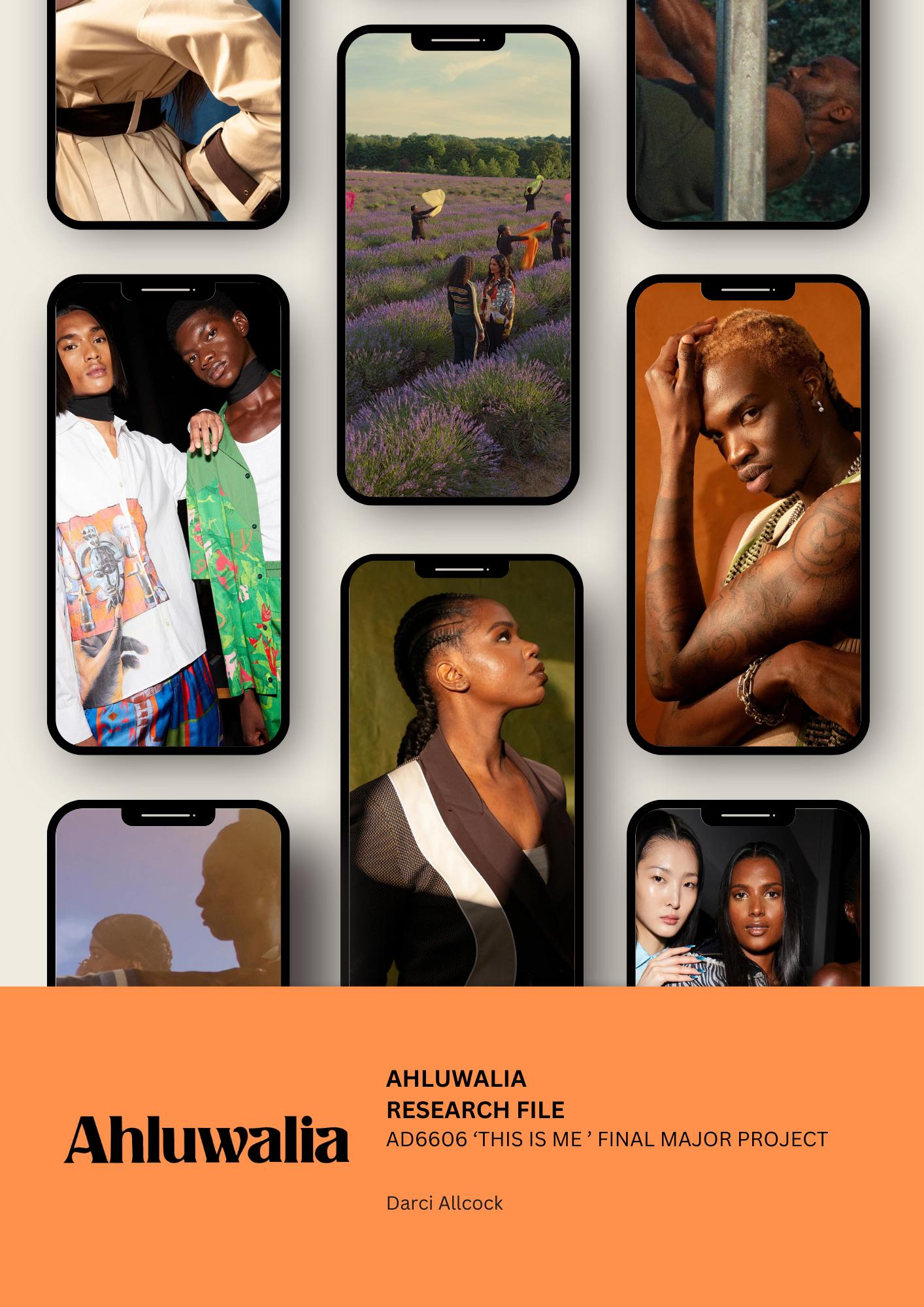

Priya Ahluwalia: Indian-Nigerian designer championing sustainable fashion
(January 28, 2022) Who could have thought that a trip to Lagos in Nigeria and Panipat in India would give birth to a fashion label that will become the face of sustainable fashion in the international market? But London-based designer Priya Ahluwalia was determined to make people rethink their fashion choices, after spotting piles of waste textile. She found the solution in upcycling, and went on to create an eponymous label that has its roots in heritage and sustainability.
In 2021, the 31-year-old joined hands with Microsoft to re-imagine sustainable fashion by merging design, culture and technology, through an app – Circulate – that allows the public to donate their used clothes for upcycling rather than disposing in a landfill. “In both Indian and Nigerian cultures, it is tradition to pass clothes and personal effects down from generation to generation. I personally have lots of special items from different family members that are very dear to me. This ritual was a key inspiration when developing Circulate,” she said in a statement.
Priya Ahluwalia is a name to reckon with in fashion industry
The designer, who made it to the Forbes 30 Under 30 list last year, is rising up the ladder with her craft that is hugely influenced by her Indian and Nigerian heritage. She is consciously working to save the planet with every design that she creates.
A trip to two countries set the course for her career
Born to an Indian mother and a Nigerian father in London in 1992, Ahluwalia was always fascinated by colours and fashion, thanks to her mother who herself was quite stylish. This love for clothing gave birth to her desire of becoming a fashion designer, and she soon enrolled in the University for the Creative Arts, Epsom for a course in fashion.
During her graduation, something peculiar happened which set the course of her career. It was on a trip to Nigeria to meet her father in 2017 that Ahluwalia noticed hawkers on the streets of Lagos wearing some obscure items of British clothing. An inquisitive Ahluwalia rolled down the window of her car to indulge in a chit-chat with them,

launch her label, Ahluwalia with sustainable principles.
Her debut collection was proof of her conscious choices as she used second hand garment reworked as menswear to highlight the industry’s problem with waste. It’s not just her technique and material choice but also her production methods that set her apart as a designer. For her Summer Spring 2019 collection, the beading on her patchwork pants was done by Sewa Delhi, an organisation that specialises in getting rural Indian women into fairly paid work that fits around their family schedule. The collection was such a hit that it won her the H&M Global Design Award 2019. The same year, she collaborated with Adidas at Paris Fashion Week for Autumn/Winter 2019 and took over the ramp at London Fashion Week 2020 with her Spring/Summer 2021 collection.
Sustainable fashion is the key
All the pieces at Ahluwalia are made exclusively from recycled deadstock. She is one of those rare young designers who are openly addressing issues like climate crisis and sustainability. “I think the correlation between young designers talking about these issues is that more young designers are from BAME (Black, Asian, Minority Ethnic) backgrounds than ever before. This means that for the first time, designers from ethnic minorities are able to share their stories and work through their own voice,” the Forbes 30 Under 30 designer told CNN.
Since the launch of her label, Priya has been drawing inspiration from her Indian and Nigerian roots for her collection, and that’s what makes her work unique and intriguing at the same time. “I am always inspired by my heritage and upbringing. I am Nigerian and Indian, and I was brought up in London, they are all places with such a wealth of culture and inspiration. I love the vibrancy of Lagos style,
the craftsmanship of Indian textiles and the typical mixed wardrobe of a London man. They fuse together to create collections that are serious and playful at the same time,” she told GQ.
In just four years, Ahluwalia has become a rising star in fashion –someone who is making the world rethink about their sartorial choices and asking the fashion industry to make conscious choice to reduce the carbon footprint by opting for sustainable fashion.
Follow Priya Ahluwalia on Instagram
My Notes:
Page 1
(January 28, 2022)
Priya Ahluwalia was determined to make people rethink their fashion choices, after spotting piles of waste textile.
upcycling
merging design, culture and technology,
“In both Indian and Nigerian cultures, it is tradition to pass clothes and personal effects down from generation to generation. I personally have lots of special items from different family members that are very dear to me. This ritual was a key inspiration when developing Circulate,” she said in a statement.
Consistently references her culture.
Page 2
She is consciously working to save the planet with every design that she creates.
fascinated by colours and fashion,
Ahluwalia noticed hawkers on the streets of Lagos wearing some obscure items of British clothing.
Page 3
second-hand clothing market in the city, that has stocks coming in from unwanted donations to British charity shops and then sold by various traders for profit
huge amounts of clothes that are discarded by Western countries each year.
released a book titled Sweet Lassi that had the imagery of these places as well as the pictures from her MA collection which was made from repurposed fabrics
Page 4
her production methods that set her apart as a designer.
beading
patchwork
made exclusively from recycled deadstock
drawing inspiration from her Indian and Nigerian roots for her collection
unique and intriguing
I love the vibrancy of Lagos style Page 5
craftsmanship of Indian textiles and the typical mixed wardrobe of a London man. They fuse together to create collections that are serious and playful at the same time,
The stories your clothes could tell: How Ahluwalia and EON are powering sustainable fashion with technology
July 26, 2023 | Elham Rizi-Shorvon
Scanning your clothes to reveal their hidden stories, or immortalising the sound waves of your favourite songs in fabric might sound like the garments of the future, but these are just some of the ways that designer Priya Ahluwalia is harnessing technology to create the next generation of fashion.
In her Autumn/Winter 2023 collection, Symphony, Ahluwalia aims to make garments traceable, intelligent, and interactive.
“Symphony was inspired my relationship with music and the music that has inspired me,” explains Priya Ahluwalia, founder and creative director of her eponymous fashion label. And the life cycle of clothes is, quite literally, woven into the fabric of Ahluwalia’s clothes.
Digital identifiers (or Digital IDs) powered by EON’s Product Cloud platform, built on Microsoft Azure, provide each garment in Ahluwalia’s new collection with a unique personal fingerprint. These Digital IDs reveal the story of the garment’s creation, the journey to your closet and the best way to care for it.
“Music is woven into each piece, creating a story that is personal to me. Thanks to technology, you can hear that story for yourself and, I hope, feel a deeper sense of connection with the piece you’re wearing.”
In a panel to discuss the collaboration, Priya Ahluwalia was joined by Natasha Franck, founder and CEO of EON, and Maruschka Loubser, Microsoft’s Director of Global Brand Partnerships, to discuss the inspiration behind the Symphony collection and the significance of
connecting with customers through meaningful stories.
The global potential of moving from analogue to digital
While Priya Ahluwalia confesses to being an analogue girl at heart, the pandemic served as a catalyst for integrating technology into her brand. “As a creative, I really like doing things in analogue, whether it’s printing mood boards or drawing on paper. But Covid made me really think about technology and how it fosters connectivity. Suddenly we couldn’t connect with customers or the community in the same way.”
Covid restrictions shifted the launch for her second book, Jalebi, from an in-store event to a virtual experience, expanding its reach globally. “It allowed the project to travel so much further. Everyone could view the exhibition and that’s when I realised how tech can bring people along on the journey. It’s amazing how far an idea can go with technology and that’s what I love about it.”
Inspired by the Jalebi launch, Ahluwalia was keen to explore more tech innovation. Having already had a partnership with Microsoft, EON – a Microsoft for Startups alum – seemed like the natural fit for a collaboration. Maruschka Loubser, describes the collaboration as a harmonious meeting of minds and values.
“I was excited to bring two great partners together. One of the reasons I wanted to work with both EON and Ahluwalia is the alignment of values that they both stand for. Their innovation fuses what Microsoft aims to do in terms of empowering people through our technology; inspiring creativity and innovating for a better world.”
Product identity: A digital passport for
clothes
As Natasha Franck explained: “The Internet enabled us to buy fashion online, and now with IoT (Internet of Things), it’s integrating with physical products. This move connects products to an intelligent and regenerative system, making IoT the link between people and products”.
What sets this integration apart is the potential to unlock accountability across the fashion supply chain, solving a significant barrier to circularity, which Franck believes is product ID. “Imagine trying to run a business without a barcode,” she said. “You can’t manage assets that you can’t identify.”
Just as barcodes revolutionised businesses, digital product passports will require brands to disclose essential information like origin, production, materials, and sustainability details. By embracing IoT and digital IDs, Ahluwalia’s Symphony collection sets a new standard for transparent and sustainable fashion practices.
The inspiration behind the Symphony collection
Tech is seamlessly weaved into Ahluwalia’s collection by authentic storytelling, which she believes to be crucial when asking people to invest in products, especially in the realm of contemporary luxury.
“I think people increasingly want the products they buy to have meaningful values behind them,” she said. Ahluwalia’s experience has shown that storytelling is what resonates with her customers. “It’s clear from my brand that storytelling resonates. It gives people the opportunity to be connected to a world.”
As a Londoner with Nigerian and Indian heritage, Ahluwalia is committed to promoting a diverse world through her stories. “The stories I tell are about representation. That means a lot to people in an industry that has, until recently, not been very representative.”
The result of her efforts is Symphony, a culturally rich tapestry laid to the soundtrack of Ahluwalia’s life. “Some pieces draw inspiration from vintage Indian sitar music, Nigerian musical instruments, album covers, music videos, the soundwaves of my favourite songs –everything to do with world of music. It’s never a literal interpretation but it might be the energy I get from it, the soundwave from a song, or the colours from an album cover.”
Weaving technology into sustainable fashion
The stories themselves are unlocked through digital technology. QR codes on the labels lead to exclusive content; customers can access behind-the-scenes details, interviews with the creative team, and sustainability information, ultimately fostering a personal connection
A mobile phone is used to take a photo of the QR code on the label of the ‘Kiara’ Ahluwalia dress.with the garments they invest in.
“The stories you see in the clothes aren’t obvious because I like things to be nuanced. There’s a lot of detail that someone who buys it might not be aware of. The technology enables people to find out the thinking behind each garment. There’s a reason why one of the wave prints is three centimetres and not four – there’s a lot of thought that goes into each piece.”
Generally speaking, one of the most exciting aspects of digital ID is that the stories they represent can continue to be shared from one owner to the next. As Franck, explained, “It enables instant resale, contributing to a circular fashion economy.”
She sees this as a tipping point for the fashion industry, where digital twins may have a cloud storage impact, but their contribution to sustainability outweighs the nominal storage cost. “That’s another reason we chose Microsoft: their cloud storage is one of the most sustainable in the industry,” Franck explained.
The art of the possible with technology
Symphony Unlocked — the collaboration between Ahluwalia, EON and Microsoft — is the culmination of months of hard work. Loubser describes it as “piloting the art of what is possible with technology, within the fashion space. Our work empowers people to create their own solutions; we utilise AI and Azure Cloud to democratise technology, allowing everyone — from small start-ups to big companies — to achieve their vision.”
Franck echoes this from her own experiences at EON. “Adding new capabilities, such as streaming, becomes easier as leverage technologies that already exist. We don’t need our own cloud or data storage centres as we can quickly build using Microsoft’s
prebuilt tools.”
Ahluwalia admits feeling daunted at the prospect of venturing into the digital sphere but emphasises the importance of a clear vision and strong partnerships. “Tech can feel scary or intimidating when you’re not in that space. Partnering with Microsoft and EON enabled us to innovate in spaces that we’re not typically in. For me and for my team, it’s important that we learn from other people.”
As Loubser explained, the partnership was seamless. “I think, partly because the EON technology already existed, we could move seamlessly to creative storytelling as well as the transparency and itemised level of information.”
“The challenge lies in finding a cohesive tone of voice and creative input for all three brands for an end product that is public facing,” concedes Ahluwalia.
Priya Ahluwalia and Natasha FranckPanel attendees agreed that the messaging of the brand was clear to see. Fashion inclusive influencer, Arooj Aftab, said “The language around sustainability and sustainable fashion is often confusing. The approach by Ahluwalia, EON and Microsoft makes it easier to understand and help clarify the nuances behind circular fashion.”
But what is Priya Ahluwalia’s favourite piece from the collection? Looking at the rail of clothes — from the vibrant Kiara dress to the colour blocked ruffle dress — she gravitates toward the denim pieces. It’s the same print as on the denim jumpsuit she is wearing on the night of the panel event.
“The print on the denim features the sound waves from Whitney Houston’s I Will Always Love You; it was playing on the radio when I was born.” The epitome of powerful meaning woven into fabric.
Find out more about Ahluwalia’s Symphony collection here and download EON’s recently launched app here.
Tags: Ahluwalia, design, Digital IDs, EON, Fashion, Innovation, sustainability, Symphony, Symphony Unlocked
My Notes:
Page 1
July 26, 2023 | Elham Rizi-Shorvon
Scanning your clothes to reveal their hidden stories
Priya Ahluwalia is harnessing technology
Page 2
Digital identifiers (or Digital IDs) powered by EON’s Product Cloud platform, built on Microsoft Azure, provide each garment in Ahluwalia’s new collection with a unique personal fingerprint. These Digital IDs reveal the story of the garment’s creation, the journey to your closet and the best way to care for it.
“Music is woven into each piece, creating a story that is personal to me. Thanks to technology, you can hear that story for yourself and, I hope, feel a deeper sense of connection with the piece you’re wearing.”
Listening is easier than reading for consumers - this provides a more effective way of educating them.
Page 3
connecting with customers through meaningful stories.
The global potential of moving from analogue to digital
the pandemic served as a catalyst for integrating technology into her brand.
Covid made me really think about technology and how it fosters connectivity.
EON and Ahluwalia is the alignment of values that they both stand for. Their innovation fuses what Microsoft aims to do in terms of empowering people through our technology; inspiring creativity and innovating for a better world.”
Product identity: A digital passport
Page 4
link between people and products”.
potential to unlock accountability across the fashion supply chain, solving a significant barrier to circularity,
digital product passports will require brands to disclose essential information like origin, production, materials, and sustainability details
sets a new standard for transparent and sustainable fashion practices.
“I think people increasingly want the products they buy to have meaningful values behind them,”
“It’s clear from my brand that storytelling resonates. It gives people the opportunity to be connected to a world.
Page 5
The stories themselves are unlocked through digital technology. QR codes on the labels lead to exclusive content; customers can access behind-the-scenes details, interviews with the creative team, and sustainability information, ultimately fostering a personal connection
Page 6
with the garments they invest in.
Continuation from page 5.
technology enables people to find out the thinking behind each garmen
one of the most exciting aspects of digital ID is that the stories they represent can continue to be shared from one owner to the next
“It enables instant resale, contributing to a circular fashion economy.”
Promotes desirability for second hand consumers - additional aspect of excitement.
Page 7
Ahluwalia admits feeling daunted at the prospect of venturing into the digital sphere but emphasises the importance of a clear vision and strong partnerships.
“The challenge lies in finding a cohesive tone of voice and creative input for all three brands for an end product that is public facing,
Need to find a balance between the contrasting identities of PLT & Ahluwalia.
“The language around sustainability and sustainable fashion is often confusing. The approach by Ahluwalia, EON and Microsoft makes it easier to understand and help clarify the nuances behind circular fashion.”
Fashion
Meet Ahluwalia, the designer demanding a change in the fashion industry
Priya Ahluwalia, the founder of Ahluwalia, discusses her upbringing, her inspirations and how she hopes for a fairer future within fashion
By Zak Maoui25 September 2020
The British menswear scene is being shaped by a new wave of talented young designers, many of whom are from the BAME community.
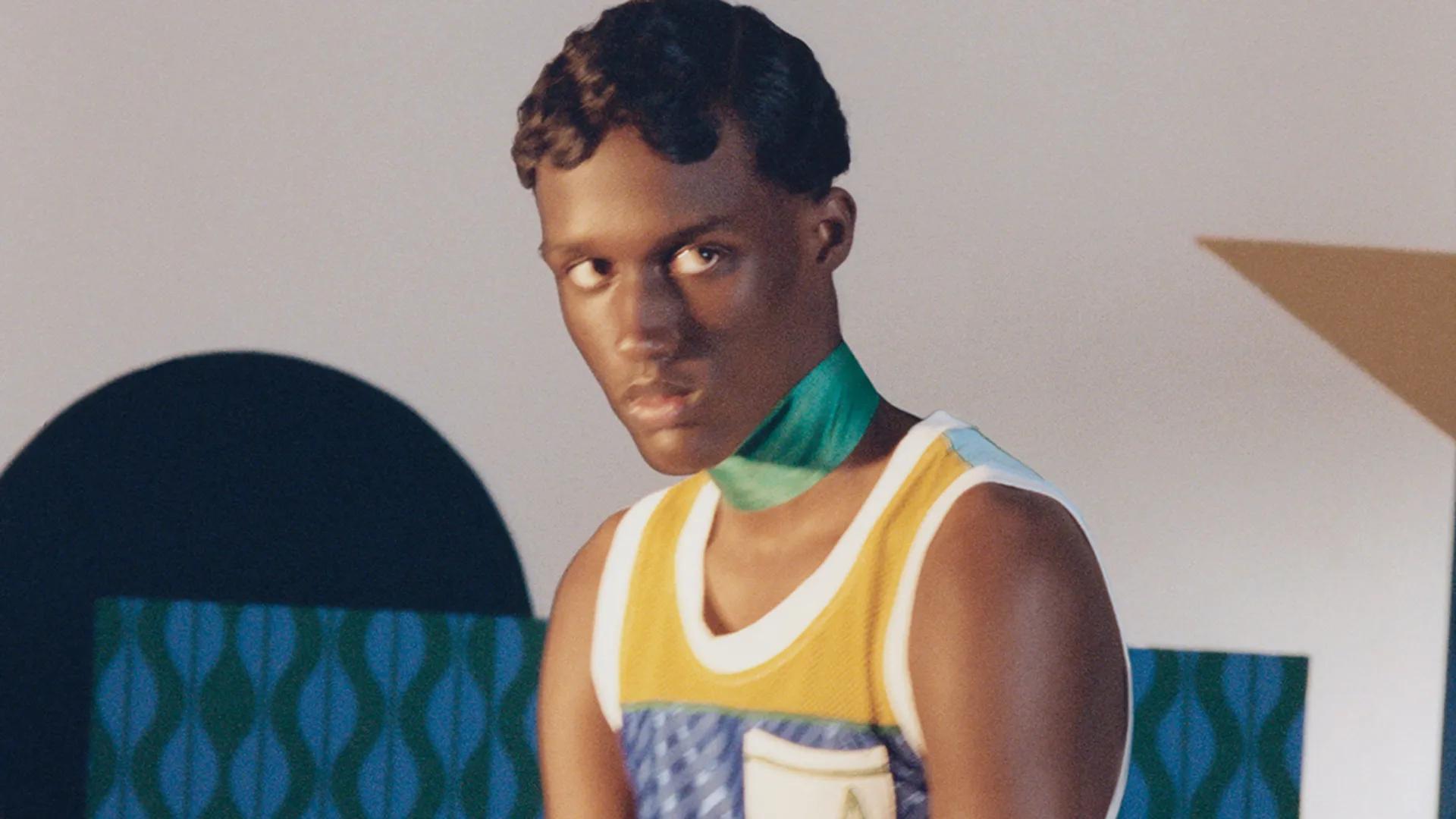
Get the GQ Recommends newsletter for the hottest drops and weekly sales picks.
Email address
Sign up to receive one or more of our free GQ newsletters. As well as receiving a regular newsletter you will receive invitations to exclusive reader events, the best subscription offers and much more.

Martine Rose, Wales Bonner, Bianca Saunders, Saul Nash and Nicholas Daley are leading the charge, regularly producing a plethora of seasonal collections and projects that place the spotlight on issues of diversity. Priya Ahluwalia, the founder of Ahluwalia, is one of the key protagonists in the aforementioned group, and has – in a short time – made her name as one of the most exciting designers working in the UK.
Born in south-west London to a father of Nigerian descent and a mother
from India, she grew up in a multi-cultured household (her step-dad is from Jamaica). Her namesake label began almost instantly after she graduated from Westminster University in June 2018, and sees her use design techniques – such as dyeing and beading – and materials directly inspired by her multifaceted heritage, as well as her London roots.
What's more, Ahluwalia's work is environmentally friendly – the designer uses vintage and dead-stock clothing for the majority of her collections.
Unsurprisingly, the designer has already seen great success. Ahluwalia won the LVMH Prize earlier this year, the H&M Design Award in 2019, she collaborated with Adidas at Paris Fashion Week for Autumn/Winter 2019 and she has just shown her Spring/Summer 2021 collection as part of London Fashion Week 2020.
The latter, titled Liberation, is Ahluwalia’s response to the past eight turbulent months. This season she used graphic prints designed in collaboration with Lagos-born British designer Dennis McInnes, all referential of archival posters, newspaper clippings and photographs from protests in 1960s Nigeria, to highlight the importance of the Black Lives Matter movement.
We spoke to Ahluwalia to find out more about her upbringing, her influences and what she hopes for the future of the fashion industry amid the increasingly fevered global discussion on racial inequality.
GQ: Did you always want to have a career in fashion?
Priya Ahluwalia: I always wanted to go into fashion. I can’t remember wanting to do anything else. My mum was into fashion and I’d read all her magazines, try on all her clothes. That was the leading inspiration for my interest in it. I basically channelled my whole education towards it. I did my BA at UCA Epsom, and then did my MA at UCA Westminster.
Was designing menswear always the plan?
My first project in my BA was womenswear. Then someone suggested I try menswear, so I did and I just stuck with it. At the end of the day, women are more susceptible to wearing different things and there’s more going on for them. In menswear there are these unspoken rules, and I want to push some boundaries and get men to wear some colour, loosen up a little. It’s a challenge, as traditionally men have worn the same thing for 50 years.
There’s still so far to go.
Who is the Ahluwalia man?
I don’t think the person who embodies the brand exists, or at least I haven’t met them yet. I think it's because I’m trying to make something new. That said, there are people that I’d like to get on board and get to believe in my brand. ASAP Rocky, for example. However, I think the Ahluwalia man is a new person. He’s conscious, fun, slightly erratic and a hard worker.
You don't like being labelled as a sustainable designer, why is that?
Because I was just so bored of everyone talking about it. It’s all everybody wanted to talk about, and never that I just design clothes. I’m not an environmentalist and I’m still learning, just trying to do the best I can. We just try to work with materials that are pre-existing, dead stock or vintage, and just try and create really interesting design details and quirks. Sustainability just naturally happened.
What's a career highlight for you so far?
I won the H&M Design award and, to be honest, I’ve been really blessed with a carousel of brilliant things after. I was part of the Fashion Week show in Paris with Adidas in 2019 and I met Yohji Yamamoto backstage and there were so many people there: Pharrell, Jonah Hill, Karlie Kloss, David Beckham. My mum was waiting outside (she comes to everything) and she said someone asked her if she was “Priya Ahluwalia’s mum” and she said that was the proudest moment of her life.
How has your multi-cultured background influenced you?
Firstly I've never known anything else. I guess I’m privy to different food, music and film. With regards to my label, I've put it all in there. I love the mixed wardrobe of a London man. Men in London can wear a suit or a tracksuit, and it works. I partner that with the vibrancy of the Lagos man, and then the craftsmanship of India. For example, I always use burnt orange, because it reminds me of the colour of the sand in Lagos, and I love
the Indian dyeing, beading and embroidery methods. Things are extremely nuanced in my collections and you might not see the references at first. I’m not a literal designer.
Has music played an important role in your life?
I love music, it totally influences my work. I work closely with Leo Gibbon – he’s the founder of candle brand IIUVO and he’s big on music too. We research soundscapes every season and my last collection was influenced by a lot of Caribbean music, and Jamaican music from the ’60s. My step-dad’s been an influence on me with that too.
I also grew up glued to MTV Base and I was obsessed with music videos. They're heavily influential on me. I was and still am obsessed with how musicians dressed and their attitudes. Aaliyah, Tupac, Biggie, all of them. I still love Snoop Dogg. Visually and musically. My mum was always playing great music, she has great taste. The first album she gave me was from Tupac. My dad introduced me to Mobb Deep.
What was creating a collection during lockdown like?
It was weird, but a positive was that it made me source more locally. I would go to Tooting Market, which is near my studio, and it was a really good way of being sustainable. You should support your local economy and markets usually buy their fabrics end of line anyway. Plus, loads of councils are trying to shut markets down, so it’s a nice way to support them. We partnered with Reskinned, which sourced dead stock for us.
What designers are you inspired by?
I love Martine Rose, she is so clever. She’s an example of just doing what you want. Her stuff is quirky and she thinks of interesting ways to present it.
Do you think you have a duty to speak up on current issues?
I think it’s up to everyone individually to decide if they want to speak on issues in the world. We get into a danger where we expect everyone with a public-facing role to speak on everything, but actually some people’s opinions are stupid, as they don’t know what they’re on about. I’m vocal about certain things, but I wouldn’t say it’s a designer's role to speak on everything. Certainly, if you own a business and work within a company, it’s everyone’s role to question injustice or racially charged and homophobic aggression in the workplace.
Saying that, people are seemingly interested in what designers have to say.
I’ve always been interested in politics and sociology, and I guess for me it all comes naturally to me to speak up. With my collections, I relate them to social causes and charities – for example, my book, Jalebi, was a celebration of diversity and all profits from sales went to the Stephen Lawrence Charitable Trust and Southall Black Sisters.
Have you seen much change in the fashion industry?
I’m not sure much has changed since I started designing, although it’s only been two years, I guess. I’m pessimistic, to be honest, of everyone saying they'll change their ways, as I don’t believe it. Hopefully they prove me wrong.
I don’t want racial matters to be a conversation that fades into the
background when the news cycle changes to something else. I’m staying pessimistic as it’s a lived experience of mine, I've experienced racism and been at the mercy of racist society. It’s not easy for me to feel optimistic, in the same way that a white person who has been newly introduced to ideas of racism can be optimistic. Let’s see. I hope it will change. I also hope that people in supply chains and the planet will be given the respect they need.
What's your opinion on fast fashion?
It would be great if people stopped buying fast fashion, but it's the fault of capitalism at large – big brands putting profits before people. Add to that consistent advertising, which is shoved in our face, and all those influencers on Instagram in new outfits every day. That said, sustainability is a privileged thing to be discussing. Someone could be so passionate and really bloody care about the planet, but they’re broke and their boss is a wanker and they can’t afford to buy sustainably. A jar of organic honey is so expensive. So they reach for fast fashion, as it's easy and often looks OK. I’d never say to an underpaid nurse or someone with three kids, “Don’t go to Primark.” It’s not their fault that it’s so expensive to buy good, well-made, sustainable things. The fault lies with companies like Primark that care more about profit margins than anything else.
If I go to a fabric supplier and get a hanger of a material, there’s always a sustainable option, but it’s so much more expensive. But if companies that can afford it bought sustainable fabrics more, the price would come down and then my kind of brand could afford it. Yet profits are important to big brands. That balance needs to be adjusted. The power lies with big companies who can afford to make change.
Now Read
The best black-led and owned fashion and grooming brands to buy from, celebrate and support
All the style lessons we learned from London Fashion Week 2020
Best new menswear items in the world this week
My Notes:
25 September 2020
Page 1
Page 2
key protagonists
Page 3
she grew up in a multi-cultured household graduated from Westminster University in June 2018 design techniques – such as dyeing and beading – and materials directly inspired by her multifaceted heritage, as well as her London roots.
Page 5
environmentally friendly – the designer uses vintage and dead-stock clothing for the majority of her collections.
Ahluwalia won the LVMH Prize
H&M Design Award in 2019
collaborated with Adidas at Paris Fashion Week for Autumn/Winter 2019
shown her Spring/Summer 2021 collection as part of London Fashion Week 2020.
This season she used graphic prints designed in collaboration with Lagos-born British designer Dennis McInnes, all referential of archival posters, newspaper clippings and photographs from protests in 1960s Nigeria, to highlight the importance of the Black Lives Matter movement.
STORYTELLER.
BA at UCA Epsom, and then did my MA at UCA Westminster.
Page 7
I think the Ahluwalia man is a new person. He’s conscious, fun, slightly erratic and a hard worker.
I’m not an environmentalist and I’m still learning, just trying to do the best I can
We just try to work with materials that are pre-existing, dead stock or vintage, and just try and create really interesting design details and quirks.
Page 8
vibrancy of the Lagos man, the craftsmanship of India.
I always use burnt orange, because it reminds me of the colour of the sand in Lagos
Acknowledge this colour through the collaboration!!
Page 9
Indian dyeing, beading and embroidery methods
I love music, it totally influences my work.
How can GEN Z music influence the work of PLT?
Page 11
I love Martine Rose, she is so clever. She’s an example of just doing what you want. Her stuff is quirky and she thinks of interesting ways to present it.
Research Martine Rose’s work and how she tells her stories.
Certainly, if you own a business and work within a company, it’s everyone’s role to question injustice or racially charged and homophobic aggression in the workplace.
With my collections, I relate them to social causes and charities – for example, my book, Jalebi, was a celebration of diversity and all profits from sales went to the Stephen Lawrence Charitable Trust and Southall Black Sisters.
Page 13
What's your opinion on fast fashion?
Page 14
the fault of capitalism at large – big brands putting profits before people.
all those influencers on Instagram in new outfits every day
What if the influencers promoted DIGITAL outfits through AI beings?
Someone could be so passionate and really bloody care about the planet, but they’re broke and their boss is a wanker and they can’t afford to buy sustainably
Understanding of the reasoning behind consumers buying fast fashion when it meets their affordability.
easy and often looks OK
The fault lies with companies like Primark that care more about profit margins than anything else.
Ahluwalia may want to work with a fast fashion company to help them CHANGE their operations - she can’t be totally against working with these companies as she worked alongside H&M.
if companies that can afford it bought sustainable fabrics more, the price would come down
Yet profits are important to big brands. That balance needs to be adjusted. The power lies with big companies who can afford to make change.
PLT is a massive company that has the opportunity and affordability TO make a change.


Priya Ahluwalia is the real deal
13 Nov 2023 | Updated on: 16 Nov 2023 | By Anna Solomon
Priya Ahluwalia is not a people-pleaser. She possesses an insouciant freedom from the conventions of polite conversation that I imagine is probably quite liberating – she doesn’t coax or encourage, doesn’t ‘mmm’ and ‘yeah’. She didn’t even turn on her video during our Zoom call, citing technical issues. She’s amiable, sure. Just not the sort of person who offers it all up on a plate.
Which, after years of doing interviews with people ‘in fashion’, I can tell you is rare. Usually, you give a spokesperson a soapbox and they’ll regurgitate their entire press pack. Ahluwalia is the polar opposite. She’s not going to pitch for you. She won’t rerun the same old soundbites. Far from it.
“I was just so bored of everyone talking about [sustainability],” Ahluwalia told GQ in 2020. Which is not the sort of thing you typically hear from the mouth of a high-profile designer – especially one that was named ‘Environmental Leader of Change’ at the British Fashion Awards in 2021; someone whose label has been known since its 2018 inception for working with deadstock materials.
Looking through any given collection, you can feel it: the quirky, multilayered, slightly frenetic style that comes with scouring warehouses for recycled offcuts. “I like things with depth,” says Ahluwalia. “That really comes with using deadstock, because when you don’t have enough material to make a full garment you start to patch things together. That’s rubbed off on my aesthetics – even with a really slick piece, there’s always depth to it.”
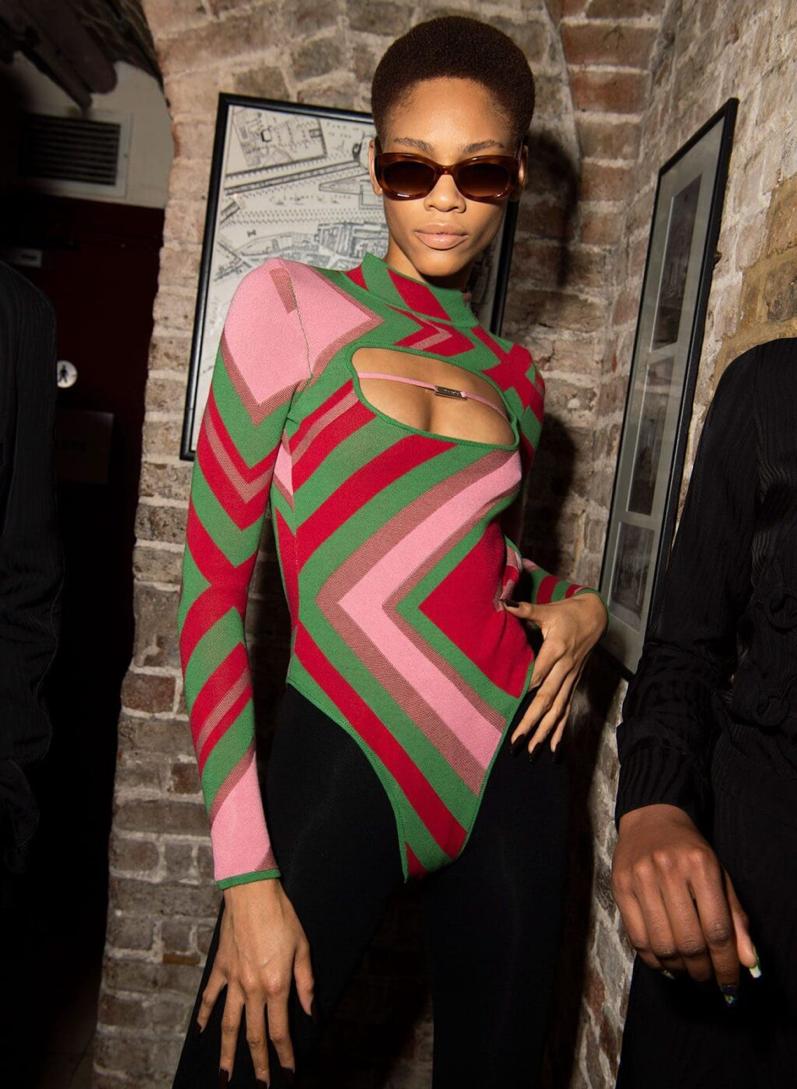
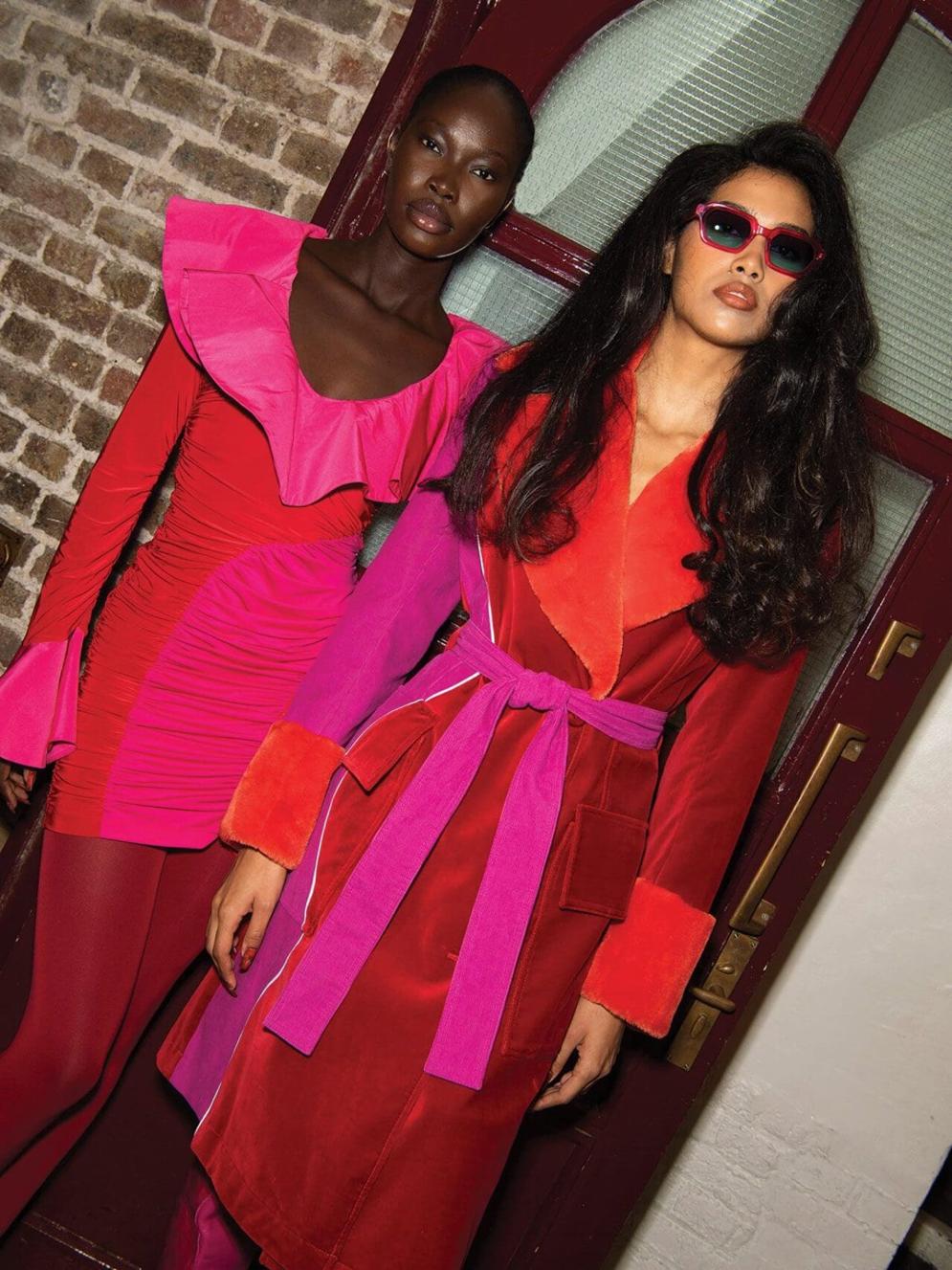
Naturally, I’m keen to find out how she reconciles this approach with her comments: “The reason I sometimes get frustrated is not because I don’t think [sustainability] is important, but I think it takes away from the fact that I’m a designer and a creative and I’m good at my job,” she says. “It makes people just want to talk to me about, like, organic materials, and that’s a fraction of it.”
It’s an unconventional position, to be sure, but refreshing. On the other end of the spectrum, you have brands touting their green credentials until they’re blue in the face, even if they don’t really have any. But here’s a designer who actually does do the sustainability thing, declining to comment on it. Is Ahluwalia the anti-greenwasher, providing a much-needed antidote to virtue-
debates raging around plus-size models, age representation, and the number of non-white designers at Fashion Week – ricochets in a similar fashion. As a designer of black and South Asian descent (her mother is Indian; her father is Nigerian), I thought that Ahluwalia might have something to say on the matter. She did, of course – just not what I expected.
“I don’t want to come across as rude. But this question, it’s quite funny to me, because I’m obviously not a part of the problem. I have a team of 10 people; there are nine women, one man, 90 per cent of us are black or brown or a mixture of both. So, like, I don’t have a diversity issue in my business. That’s not an issue that I perpetuate. So I don’t really know.” She offhandedly cites “white supremacy” and the “fetishisation of youth”, but it’s clear we won’t be chowing down on any meaty socio-political issues today.
Just as Ahluwalia refuses to be pigeonholed as a ‘sustainable designer’, she doesn’t want to be lumped into a non-white ‘box’. Unlike when she was growing up in the 1990s and ’00s, there is now a substantial cohort of POCowned labels rising through the ranks – Mowalola, Wales Bonner and Saul Nash, to name just a few. “These designers, they’re showing their authentic representation of what it is to be black or brown – there isn’t a onedimensional representation of it, because that’s not life,” says Ahluwalia. “All our creativity is different. I don’t like to be reduced to being just a black or brown designer, because there’s a multitude of things that means for different people.”
The more I nudge Ahluwalia towards the soap box, the more it becomes clear that she doesn’t want to go there. Is it important for the creation of a welladjusted society that people are exposed to different cultures, I wonder, dangling the bait? She ignores it. “I don’t want to answer. I don’t know. I don’t really understand why it’s up to me to discuss what other people need to be doing to be well-rounded, to be honest.”
OK. Enough of politics. Enough social issues. Enough probing for preachy soundbites that Ahluwalia is clearly loath to give. Who is she as a designer, away from buzzwords and box-ticking? She is a designer whose memories of her home countries inform her ideas – she takes cues from Indian embroidery and the streetwear of Lagos: “Everything that I have grown up with is naturally going to influence my work. The music I have listened to, Nollywood and Bollywood cinema, family photos, artefacts…”
London, Ahluwalia’s hometown, is another source of inspiration: “It’s a melting pot and that influences the way I look at things. I like syncretism.” The designer’s Tooting upbringing directly informed one collaboration with Clarks, in fact, which spoke to a collective experience of London kids: traipsing to the shop to get their school shoes. “Those sort of moments define your taste forever, right?”
“There are companies that could shift the needle, and that’s where the sustainability conversation needs to be focused”
PRIYA AHLUWALIA
Ahluwalia started as a menswear label (the company has only been doing women’s collections since 2021), once again taking cues from a patchwork of sources: Indian and Nigerian street style, male celebs like Donald Glover and A$AP Rocky, Savile Row tailoring. The designer was drawn to men’s clothing for the simple fact that, traditionally, the category has been so much more limited than women’s – Ahluwalia wanted to see whether she could mix it up. “Men have been wearing pretty similar things for the past 50 years. I liked the idea of having the opportunity to push those boundaries – to play around with the codes of menswear.”
What else? She is a designer who loves to use mixed media: “When I’m creating a season, I read a lot, I watch a lot of films, and I visit exhibitions and galleries. All of that feeds into this bank of research that I have, and I curate projects from that.”
Ahluwalia’s latest ready-to-wear collection, Symphony, is inspired by the music that has shaped her life, including artists like Sade, Lauryn Hill and Mobb Deep, with a dose of Prince and Queen, and a sprinkling of Punjabi and Nigerian beats. In 2020, Ahluwalia participated in GucciFest, where she created a short film called Joy; she fell in love with filmmaking and, at the end of last year, was signed to Black Dog Films.
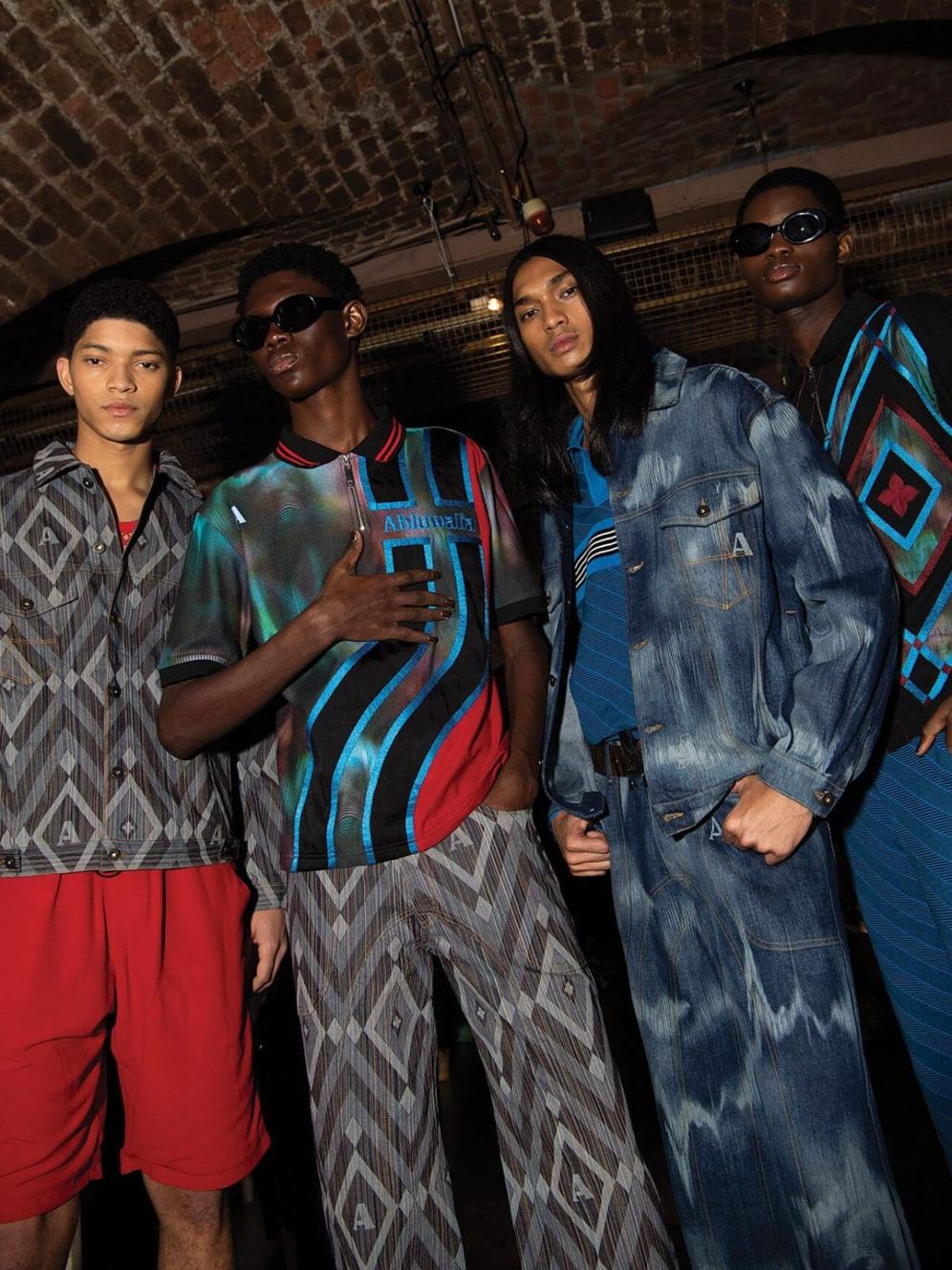
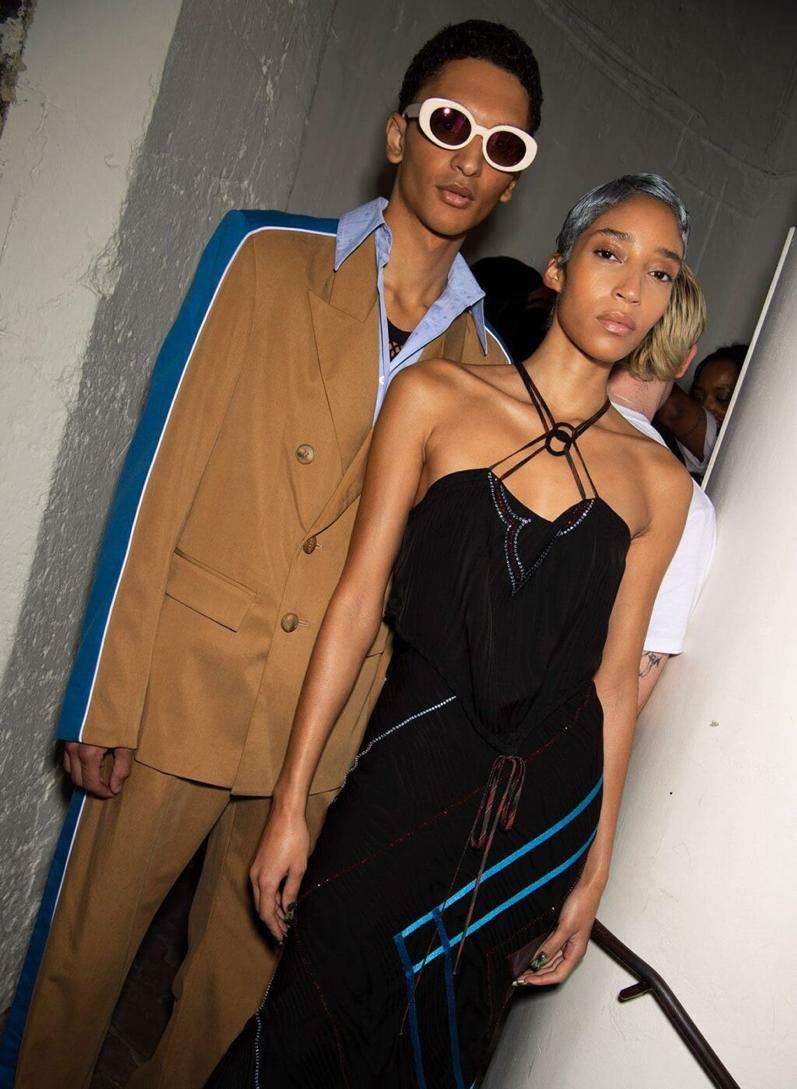


What about Ahluwalia the person? She loves getting dressed up, and her nails are always immaculate. “The way that I like to accessorise and look, I’m definitely like a London girl,” she says. “That said, there is definitely time for a tracksuit. I mean, I wear a tracksuit to work.”
When I ask Ahluwalia about her favourite music artists, something shifts – for the first time, she relaxes and enthuses: “Oh God, it’s so difficult. I don’t know how to answer because I just love so much stuff. Okay, I’m gonna say Sade.”
The matter of her favourite film is equally torturous – maybe 1998 Hindi musical Kuch Kuch Hota Hai – but she settles on Homegoing by Yaa Gyasi (an historical fiction about slavery) as the book that has changed her life. On the subject of books, Ahluwalia’s SS24 collection was shown at the British Library, which she says “speaks to [her] love of literature”. She keeps a notepad by her bed and writes something every day.



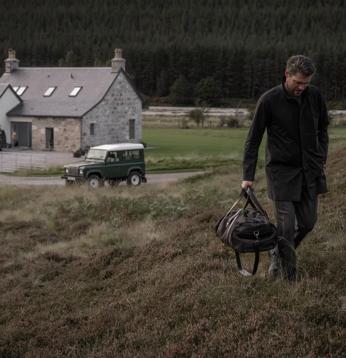

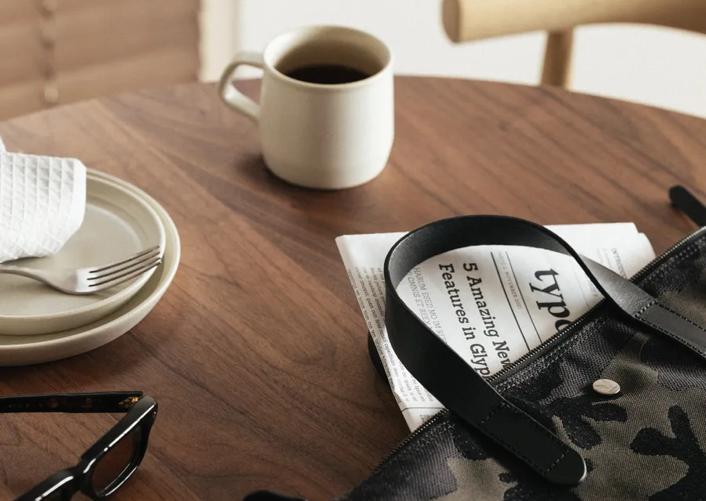
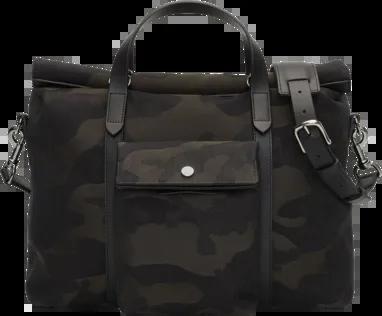
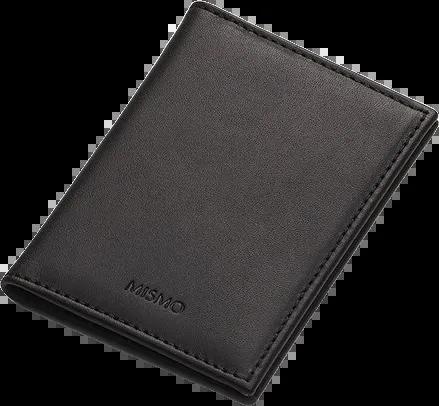
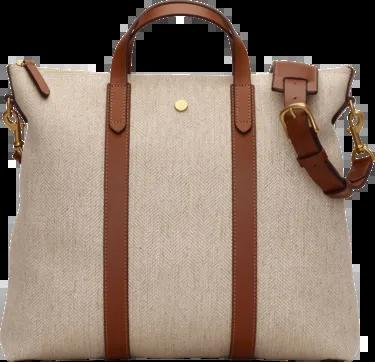
Ahluwalia says she’s a party girl trapped in a homebody, conceding that she’d rather be out on a Friday night, but usually stays in. She loves the food that her Indian nana cooks, rivalled only by goat suya (a Nigerian kebab). “This is the tricky thing about being mixed race,” she laughs. Her favourite person in the world is her mum.
“Black and brown people should just be able to have joy,” says Ahluwalia towards the end of our interview. “I think that I should be able to just enjoy putting nice things out without having to be some sort of representative to fix the whole world.”
Suddenly, her reticence makes sense – it must be exhausting, constantly politicising your existence. And I saw how she came alive when she was allowed to talk about her passions, rather than having to hash out the whole fashion world’s ills. Here is a complex, multi-layered individual – not a mouthpiece. She doesn’t have all the answers, and has never claimed as much.
“Everyone thinks I’m some sort of political spokesperson,” says Ahluwalia. “I just represent an authentic experience.”
Visit ahluwalia.world
DISCOVER MISMO M/S Soft Work - Into Th £496 MISMO Cards - Black - Black ve £60My Notes:
Page 2
‘Environmental Leader of Change’ at the British Fashion Awards in 2021; someone whose label has been known since its 2018 inception for working with deadstock materials.
Page 3
quirky, multilayered, slightly frenetic style that comes with scouring warehouses for recycled offcuts. “I like things with depth,” says Ahluwalia. “That really comes with using deadstock, because when you don’t have enough material to make a full garment you start to patch things together. That’s rubbed off on my aesthetics – even with a really slick piece, there’s always depth to it.”
But here’s a designer who actually does do the sustainability thing, declining to comment on it
Opposite of greenwashing. Sustainable always but doesn’t want the talk of this to distract others from recognising her creativity.
anti-greenwasher
Page 6
Ahluwalia refuses to be pigeonholed as a ‘sustainable designer’
Page 7
She is a designer whose memories of her home countries inform her ideas – she takes cues from Indian embroidery and the streetwear of Lagos: “Everything that I have grown up with is naturally going to influence my work. The music I have listened to, Nollywood and Bollywood cinema, family photos, artefacts...”
London, Ahluwalia’s hometown, is another source of inspiration: “It’s a melting pot and that influences the way I look at things. I like syncretism.”
collaboration with Clarks, in fact, which spoke to a collective experience of London kids: traipsing to the shop to get their school shoes. “Those sort of moments define your taste forever, right?”
Pivotal world/life moments stay with you forever - to ignite appeal around an exclusive collection not only does it need to be memorable, but it also needs
to stand the test of time and not become outdated - historical moments?
Page 8
She is a designer who loves to use mixed media: “When I’m creating a season, I read a lot, I watch a lot of films, and I visit exhibitions and galleries. All of that feeds into this bank of research that I have, and I curate projects from that.”
The collaboration should branch out further than typical types of mediagame? Virtual reality? Song?
she fell in love with filmmaking
Page 9
I’m definitely like a London girl,” she says. “That said, there is definitely time for a tracksuit. I mean, I wear a tracksuit to work.”
Story should represent HER as well as what she does.
Page 10
she came alive when she was allowed to talk about her passions, rather than having to hash out the whole fashion world’s ills
“Everyone thinks I’m some sort of political spokesperson,” says Ahluwalia. “I just represent an authentic experience.”
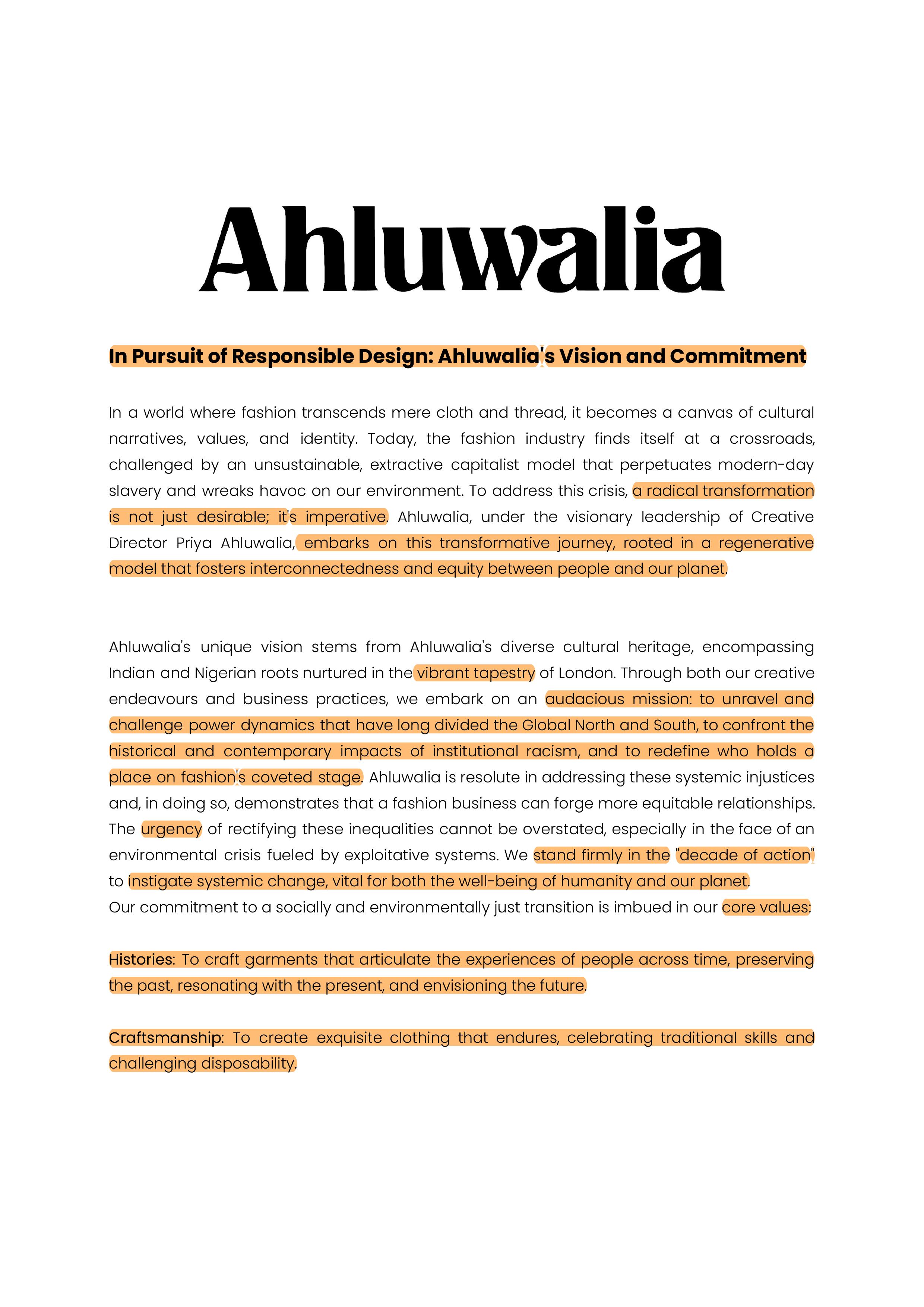
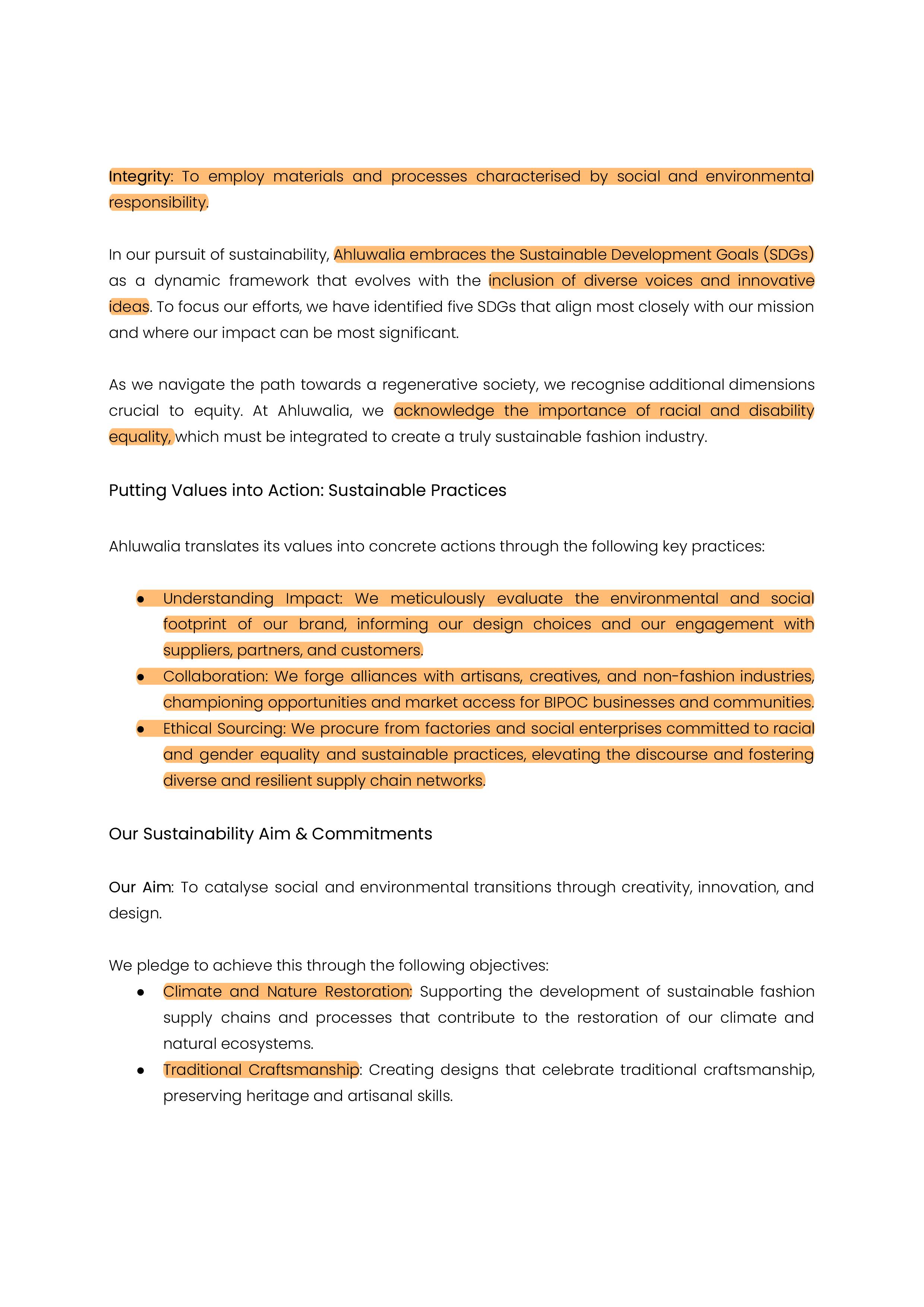
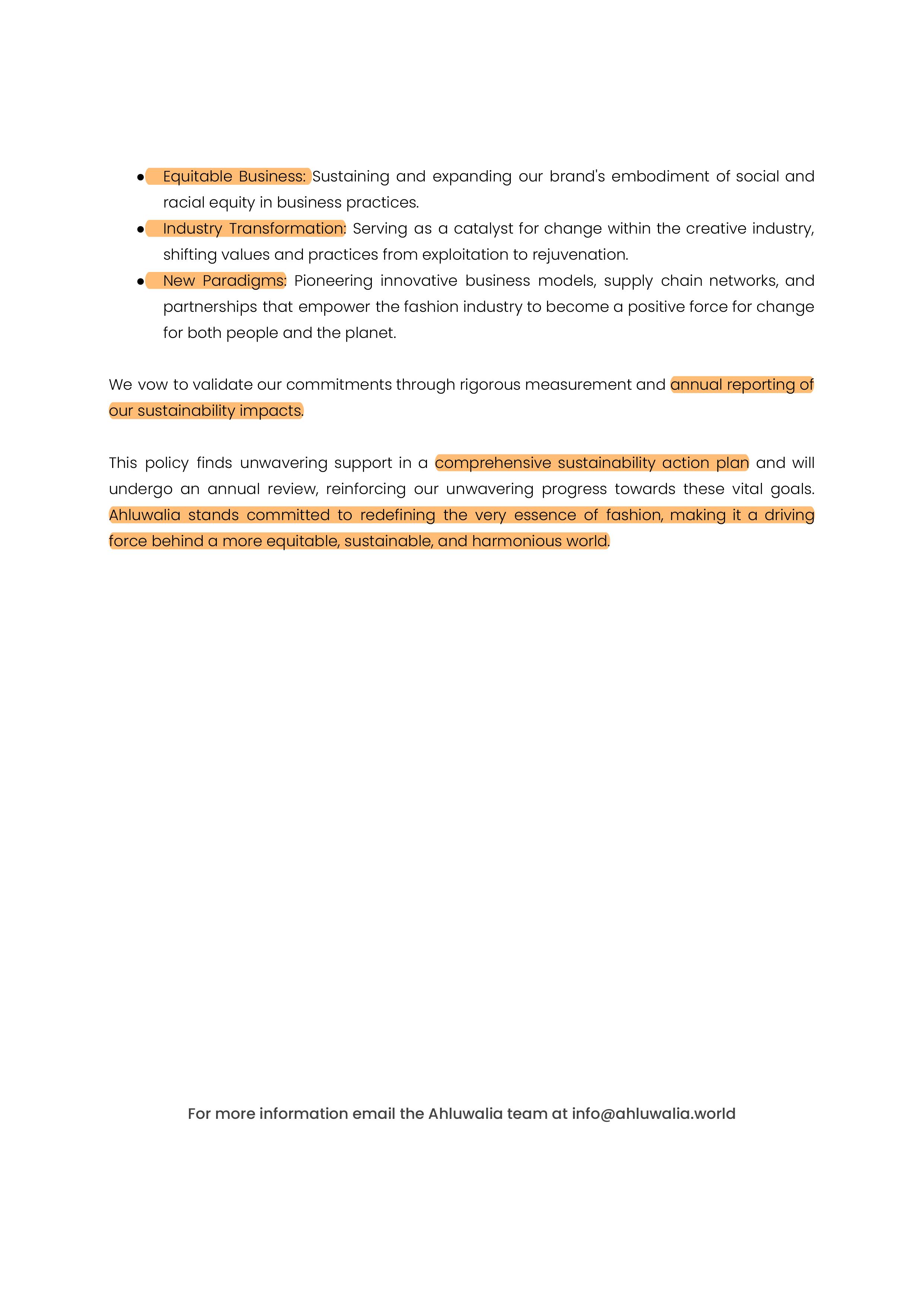
My Notes:
Page 1
In Pursuit of Responsible Design: Ahluwalia ' s Vision and Commitment
Clear statement on her website that is available for consumers to downloadtransparency.
a radical transformation is not just desirable; it' s imperative.
embarks on this transformative journey, rooted in a regenerative model that fosters interconnectedness and equity between people and our planet.
vibrant tapestry
audacious mission: to unravel and challenge power dynamics that have long divided the Global North and South, to confront the historical and contemporary impacts of institutional racism, and to redefine who holds a place on fashion ' s coveted stage.
urgency
stand firmly in the "decade of action "
instigate systemic change, vital for both the well-being of humanity and our planet.
core values:
Need to create new core values for PLT.
Histories : To craft garments that articulate the experiences of people across time, preserving the past, resonating with the present, and envisioning the future.
Craftsmanship : To create exquisite clothing that endures, celebrating traditional skills and challenging disposability.
Page 2
Integrity : To employ materials and processes characterised by social and environmental responsibility.
Ahluwalia embraces the Sustainable Development Goals (SDGs)
inclusion of diverse voices and innovative ideas
acknowledge the importance of racial and disability equality,
● Understanding Impact: We meticulously evaluate the environmental and social footprint of our brand, informing our design choices and our engagement with suppliers, partners, and customers. ● Collaboration: We forge alliances with artisans, creatives, and non-fashion industries, championing opportunities and market access for BIPOC businesses and communities. ● Ethical Sourcing: We procure from factories and social enterprises committed to racial and gender equality and sustainable practices, elevating the discourse and fostering diverse and resilient supply chain networks.
Climate and Nature Restoration:
Traditional Craftsmanship
Page 3
Equitable Business:
Industry Transformation:
New Paradigms:
annual reporting of our sustainability impacts. comprehensive sustainability action plan
Ahluwalia stands committed to redefining the very essence of fashion, making it a driving force behind a more equitable, sustainable, and harmonious world.




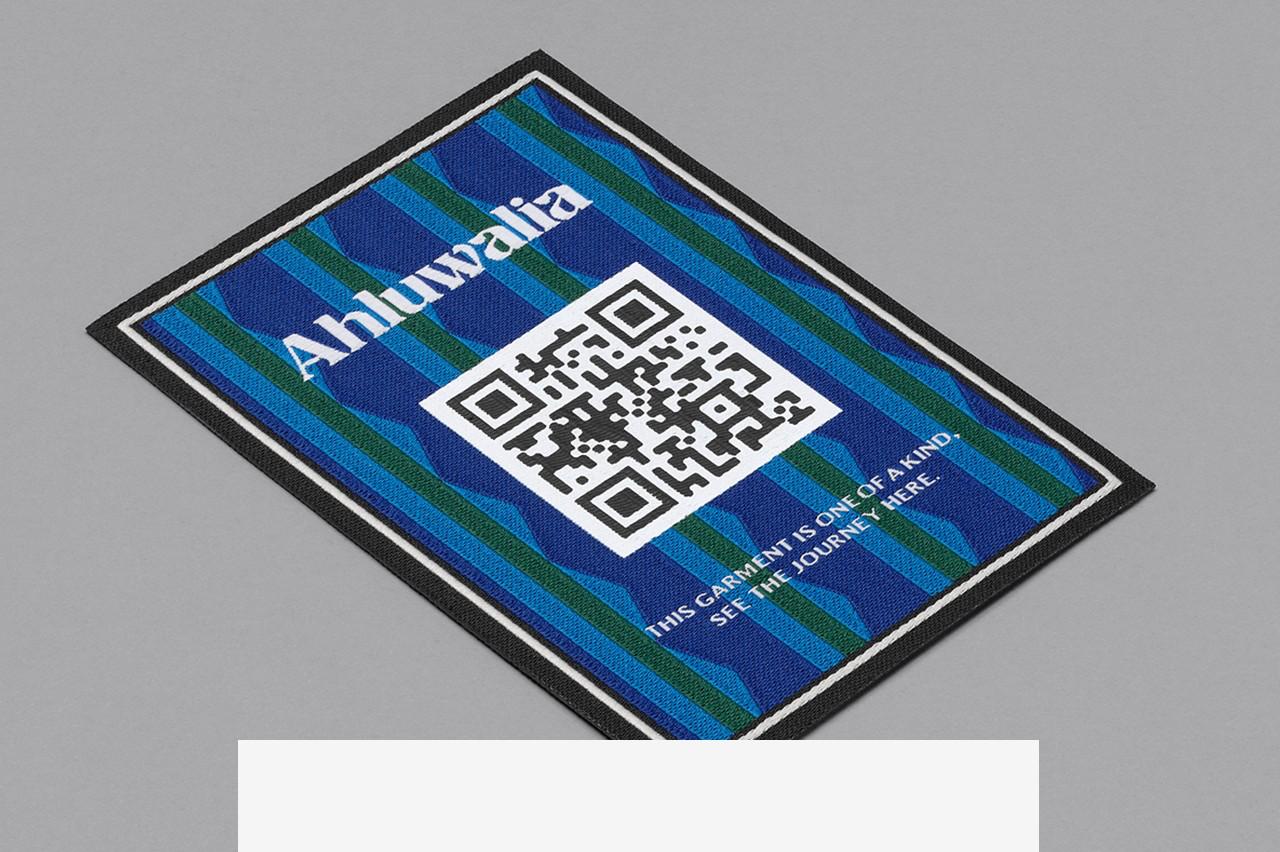
Enabling Circularity with Ahluwalia
For CFS+ (https://wordpress.globalfashionagenda.com/challenge/priyaahluwalia/) in 2020, we partnered with Ahluwalia, a pioneering fashion brand renowned for a design-led approach to sustainability, to demonstrate the opportunities to enable circular systems through digital labeling solutions.
In collaboration with Avery Dennison, for their SS21 collection, Ahluwalia designed a bespoke label, which once digitally activated has the power to tell the past, present and future story of the garment. If we can understand the past, we can unlock the present, and connect the future of our garments to their past.
To learn more about enabling circularity with digital solutions and connected labels, watch our explainer video here (https://youtu.be/FNsdapL40As)
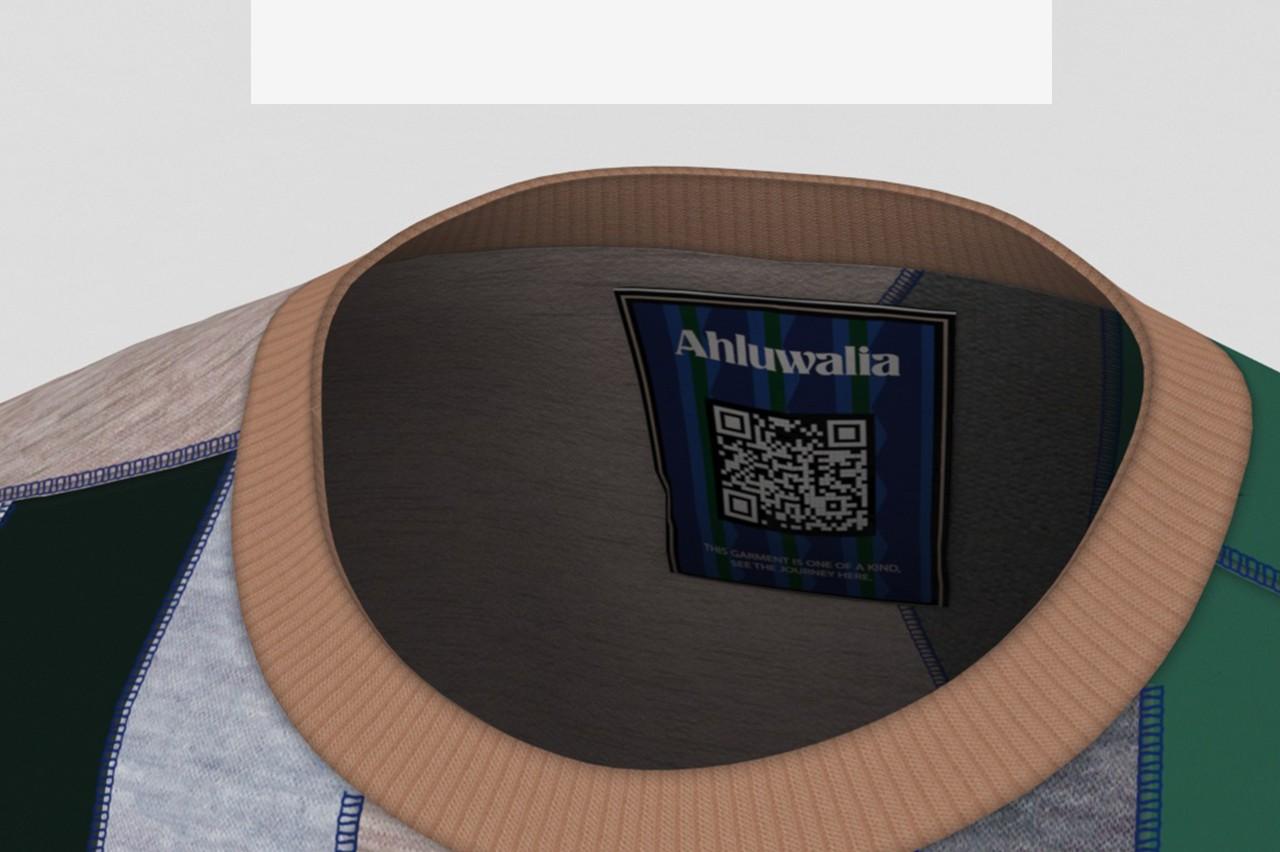
RELATED ARTICLES

(/en/home/our-services/adtrend-alert/QR-Code-MarketInsights.html)
February 2021
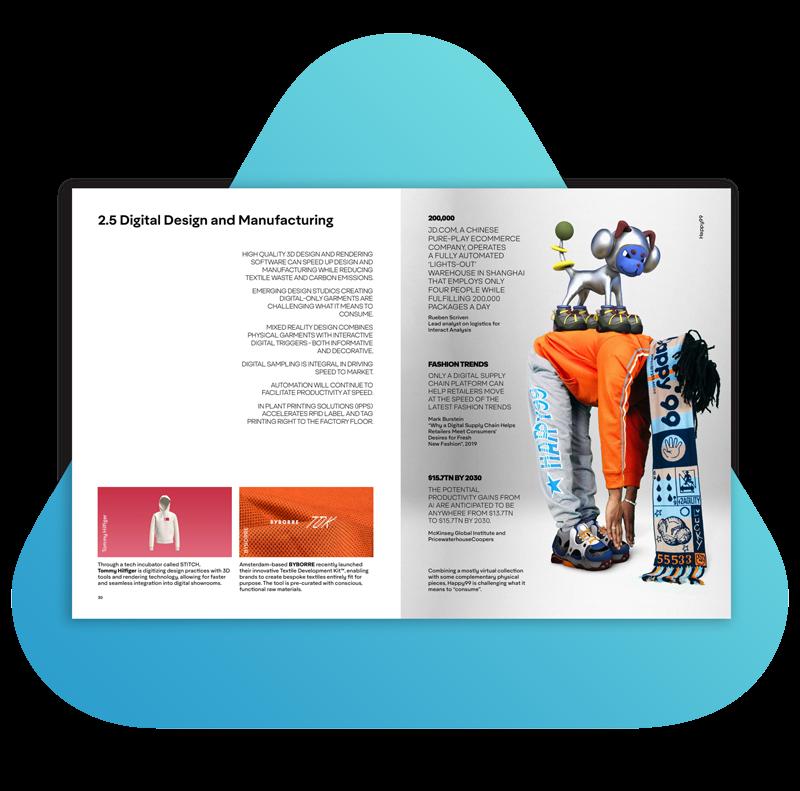
(/en/home/our-services/adtrendalert/Digital_Deep_Dive.html)
November 2020
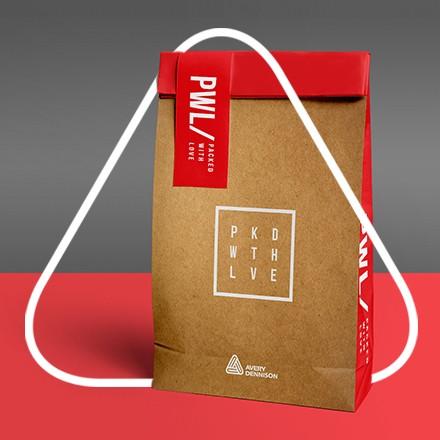
(/en/home/our-services/adtrend-alert/Reduce-YourFootprint-With-3D-DigitalSampling.html)
February 2021
My Notes:
Page 1
enable circular systems through digital labeling solutions.
In collaboration with Avery Dennison, for their SS21 collection, Ahluwalia designed a bespoke label, which once digitally activated has the power to tell the past, present and future story of the garment. If we can understand the past, we can unlock the present, and connect the future of our garments to their past.
“We Are Business Owners, You Can’t Be A Wallflower”: Priya Ahluwalia, Tolu Coker & Torishéju Dumi
Are Leading The Charge For Sustainable British Design
For today’s fashion talent, sustainability goes beyond a buzzword. Julia Hobbs meets three designers – with three distinct styles – who are aligned on a shared purpose. Photographs by Charlotte Wales. Styling by Poppy Kain.
14 December 2023
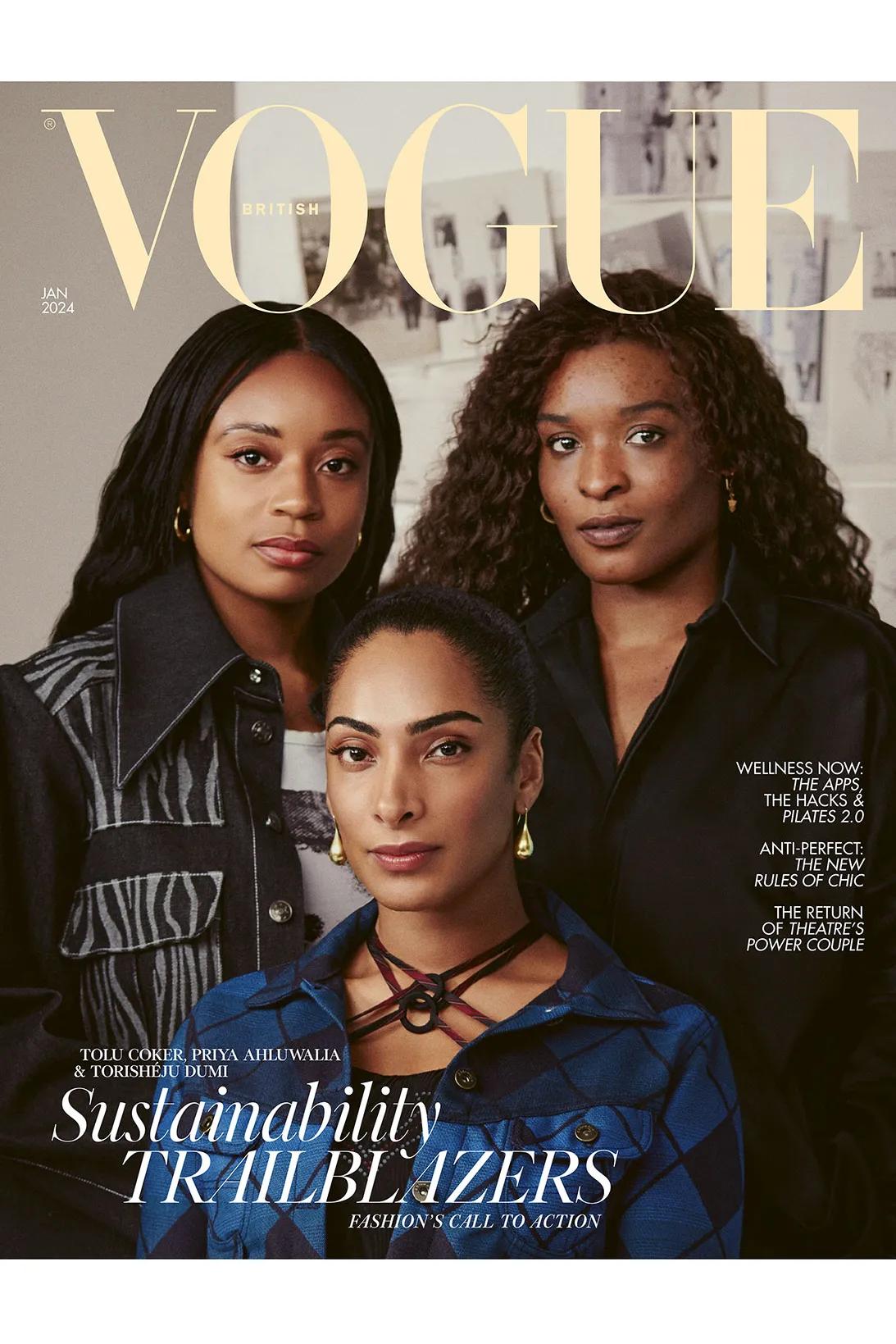

Tolu Coker, the youngest of our prodigious designer trio, is sitting cross-legged on the floor of an improvised dressing room on set for her British Vogue cover shoot, sharing an insider’s guide to her North Kensington neighbourhood. I open an iPhone Note and type: “St Augustine’s car boot sale in Kilburn. Go early.”
Charlotte Wales“It’s where the Portobello vintage traders source their pieces,” Tolu says, scrolling for a photo of the industrial knitting machines she’s discovered there – the same machines that the 29-year-old Central Saint Martins graduate used to create her breakout spring/summer 2024 collection, entitled Irapada (meaning “redemption” in Yoruba) from her livingroom atelier, inspired by the white gowns worn in south London’s Yoruba churches and Candomblé processions in Brazil.
Subscribe to British Vogue

Today, in a sunlit Tottenham photo studio, Coker’s hand-deconstructed denim will be celebrated alongside designs by her fellow cover stars, visionary creative directors Priya Ahluwalia and Torishéju Dumi, both 31. Where Ahluwalia is a master of artisanal knits and zinging prints, Dumi’s monochromatic looks are about structure; in her hands, deconstructed blazers become a blueprint for extraordinary silhouettes using offcuts of fabric salvaged from large wholesale warehouses.
These designers have built businesses on resourcefulness. “Sustainability to me is about making do with what you have. That’s in my DNA,” Dumi says. “The fabrics that I work with are always offcuts. There’s so much leftover fabric out there.” It’s a sentiment shared by Coker. “Very early on, I conditioned myself that my definition of success is about slow, steady growth and longevity – to be able to continue creating, and grow with the people around me as well,” she says, adding that fashion
doesn’t always have to be about making more clothes. “Sometimes it’s just telling a new story with what already exists,” Coker adds, which was why some of the pieces in her spring/summer 2024 collection were carried forward from a previous release.
The clothes these three women produce are innately sustainable, which isn’t, as Ahluwalia has long emphasised, “just about the yarn you choose”, but driving social and environmental change. Since graduating from the University of Westminster’s menswear MA programme in 2018 (Opening Ceremony and LN-CC bought Ahluwalia’s entirely upcycled graduate collection), she’s built a team with a high representation of Black women, inclusive of LGBTQ+ and Disabled people. “If you’re a woman, and you’re Black or brown, the opportunities available to you as a fashion designer get smaller and smaller,” Ahluwalia says.
The reality is that deserving talents are being overlooked because decision-makers are choosing to stick with the status quo. “For fashion to be new, and for creativity to thrive, we have to be open to different points of view. We need to broaden the pool of people that are part of top-level conversations, starting with who’s in the room,” she explains. “There are designers and creators who are so capable, and will flourish with the right backing.”
Beyond being less wasteful when it comes to making clothes, Ahluwalia knows how her factories treat their staff. She’s also constantly thinking of ways to reward the community that follow her brand but may not necessarily be able to afford to buy it, through invitations to her film festivals and runway shows. Indeed, five years in, the south Londoner is already on a mission to grow her namesake label into a lifestyle brand in the manner of a Ralph Lauren, encompassing everything from interiors
to restaurants – as well as film (she’s represented by Ridley Scott’s prestigious Black Dog Films production company, and has directed shorts for Mulberry and Vogue).
Torishéju Dumi – born in Harlesden, in the capital’s northwest – was the wildcard who won Paris Fashion Week. Her first-ever runway show ended the spring/summer 2024 collections with an exclamation point; her obsessive study of texture and form brought to life by an all-star model line-up including Naomi Campbell, Paloma Elsesser and Devyn Garcia, assembled by casting director Aymeric. (The stylist, Gabriella Karefa-Johnson, first spotted Dumi’s talent while sitting as a virtual judge during Central Saint Martins MA fashion graduate show in 2021.)
Campbell’s opening look featured Torishéju’s signature horned blazer, a piece that embodies her modus operandi as a designer. “The clothes I make are there to help the wearer feel like somebody,” she says. Dumi honed her exacting eye at Céline, during Phoebe Philo’s tenure. The house’s Cavendish Square atelier (with the famous purple velvet carpet that spiralled all the way up to Philo’s office) offered a masterclass in pattern cutting and familial team warmth. “Everyone was lovely,” she says of her alma mater. Some days, she was despatched to the enormous Chelsea archive, where she relished the opportunity to photograph pieces from past collections, seeing firsthand how they were made. “Everybody has their own take on why they like that era of Céline,” she notes. “For me, it’s the beautiful construction – that’s what makes good clothing.”
Dumi’s debut runway show was about realising her own autonomy. “I’m not living out people’s preconceived notions of what I should be like as a Black designer,” she says. “It’s only now, with the release of this
collection, that I actually feel free for the first time in my creative life.”
While momentum is gathering for these three industry frontrunners, financial support is increasingly harder to come by, particularly for fashion shows, which are a vital part of any rising designer’s publicity strategy. “Lighting alone will cost you a minimum of £12,000 for 10 minutes,” Ahluwalia says, leaning towards my iPhone microphone. “If any of you [reading this] want to give us money for a show, I’m taking meetings at the moment,” she says with a laugh.
“A lot of people think that more visibility equals more financial success, and that’s not always the case,” Coker explains. Each of the designer’s pathways into the industry underscores the importance of access to expert tuition and funding. Coker learnt about Central Saint Martins through a local youth centre during her school holidays, and held her inaugural runway show thanks to the support of the BFC’s NewGen initiative, which has springboarded UK fashion talents including Ahluwalia, Lee McQueen, Jonathan Anderson and Molly Goddard over the past 30 years. Without the Sarabande scholarship (awarded by photographer Sølve Sundsbø), and fabrics donated by Alexander McQueen, Dumi tells me she wouldn’t have been able to complete her MA.
Subscribe to British Vogue
Ahluwalia, meanwhile, credits Ganni CEO Nicolaj Reffstrup for sharing advice which proved instrumental in how she built her business – tools (Coker calls them Ahluwalia’s “seeds of knowledge”) that she’s keen to pass on to her contemporaries. “We are business owners, so you can’t be a wallflower,” Ahluwalia says. “People like us and buy our brands because we know what we want. That’s our job – to know what we
My Notes:
JANUARY 2024 ISSUE
14 December 2023
Page 1
Page 3
Ahluwalia is a master of artisanal knits and zinging prints,
Consider the use of these designs as a presence within the collaborationAhluwalia’s brand identity.
Page 4
driving social and environmental change
Opening Ceremony and LN-CC bought Ahluwalia’s entirely upcycled graduate collection),
See if I can find her graduate collection.
“If you’re a woman, and you’re Black or brown, the opportunities available to you as a fashion designer get smaller and smaller,” Ahluwalia says.
Could the sub brand offer a design facility where it collaborates with upcoming/ graduate designers?
Ahluwalia knows how her factories treat their staff. She’s also constantly thinking of ways to reward the community that follow her brand but may not necessarily be able to afford to buy it, through invitations to her film festivals and runway shows
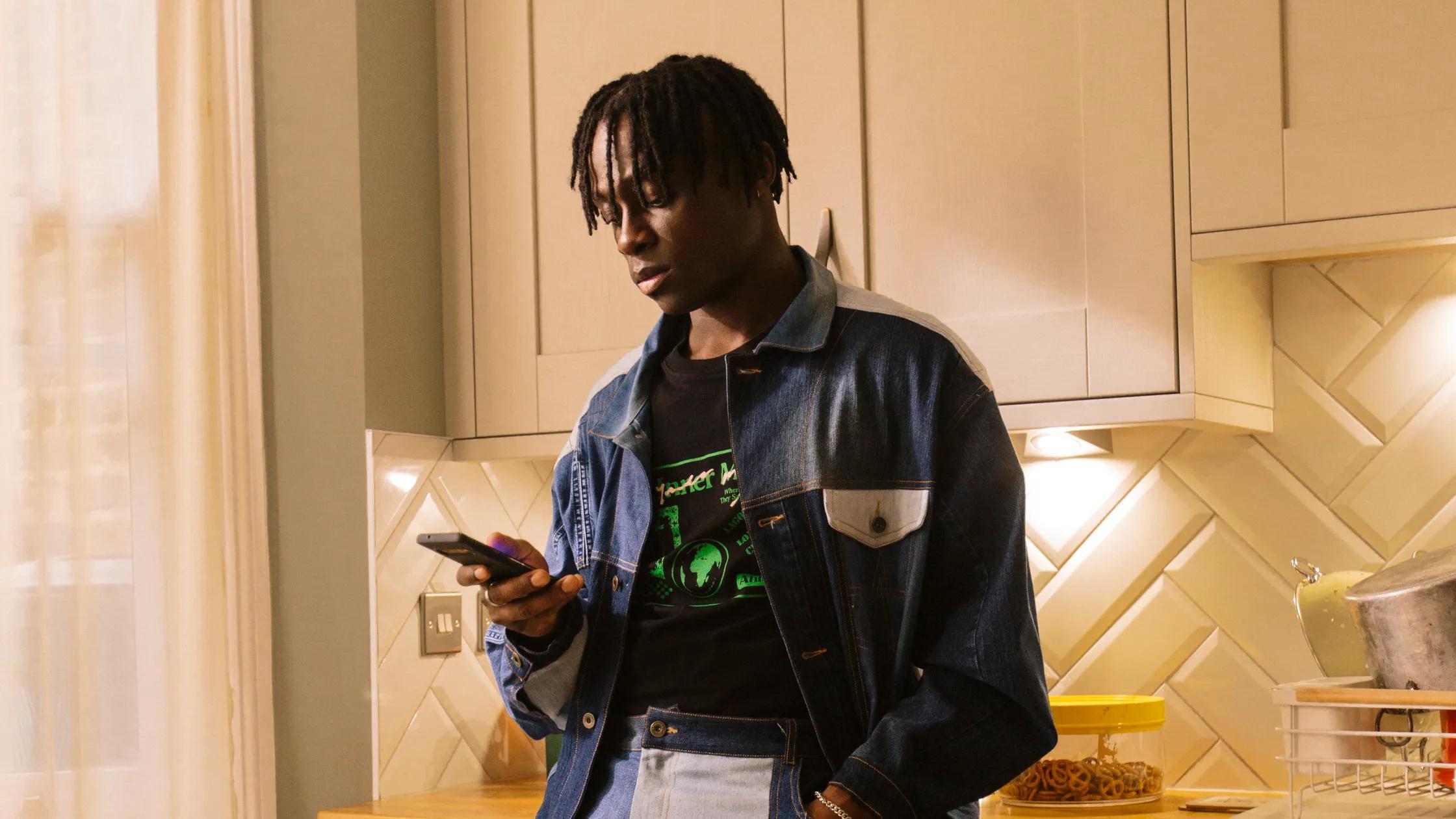
Clothing
This technological approach to sustainable fashion invites consumers to get involved by donating used pieces.
 BY DONYA MOMENIAN NOVEMBER 10, 2021
BY DONYA MOMENIAN NOVEMBER 10, 2021
British fashion label Ahluwalia and Microsoft are merging design, culture, and technology to reimagine sustainable fashion. Founder and namesake Priya Ahluwalia is sharing her dedication to ethical and environmentally friendly practices with all through Circulate. The new web app powered by Microsoft is releasing its beta launch in London, the designer's home city. It allows users to receive credit for donating gently used clothing for upcycling rather than disposing of it in a landfll. Ahluwalia will then use the donated items to create new pieces for her collections. The program is intended to create a circular fashion cycle in which clothes take on new forms instead of polluting the Earth.
Large amounts of waste are one cause of emissions, so reducing trash is a priority to establish a more ethical fashion industry. Ahluwalia and Microsoft's new program is aimed toward alleviating the problem. Circulate's mission is to make an eco-friendly alternative to throwing away clothing and to make it accessible to everyone through technology.
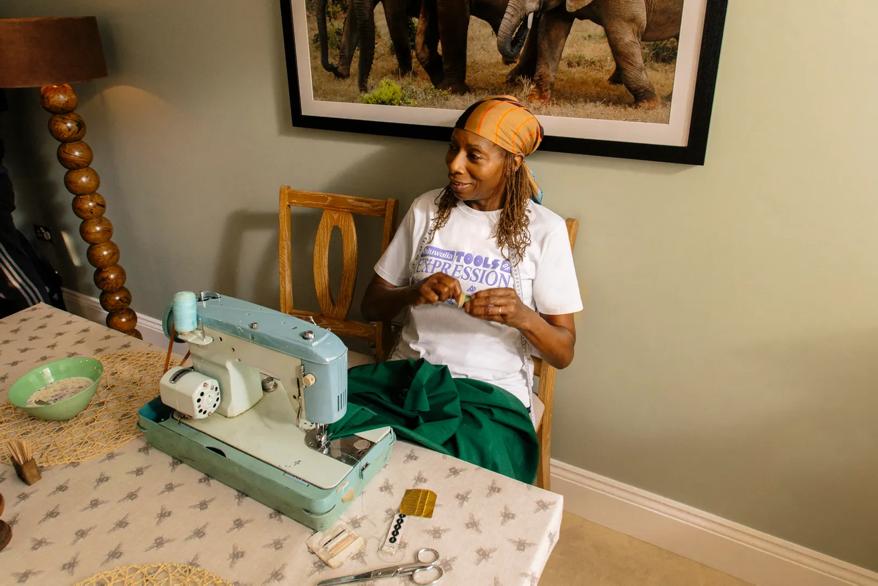
Taking direction from her Indian and Nigerian heritage, Ahluwalia created Circulate with shared practices in mind. She considered the signifcance of handing down clothing and other items to have cultural value. “In both Indian and Nigerian cultures, it is tradition to pass clothes and personal efects down from generation to generation,” she shared in a press release. “I personally have lots of special items from diferent family members that are very dear to me. For example, my great-grandad’s frst English dictionary and many clothes my mum wore in her 20s. This ritual was a key inspiration when developing Circulate.”
This is a continuation of Ahluwalia’s sustainability eforts as a designer that have similarly been infuenced by her background. After seeing the impact of clothing dumping in India and Nigeria, a common occurrence in the Global South, Ahluwalia became committed to non-harmful fashion. Taking note of the use of
COURTESY OF AHLUWALIA AND MICROSOFTsecond-hand clothes at Aswani Market in Lagos, Nigeria, and Panipat, India, the global capital of recycling clothes, she opted to repurpose pieces when designing new creations. Known for her streetwear, Ahluwalia’s pieces are taken from the used clothes and repurposed into patchwork, putting a twist on a popular trend and the growing sustainability movement. Her work has received major awards and recognition from both fashion and environmental communities.
Circulate uses Microsoft technology to screen clothing donations, which facilitates the process of collecting used pieces. The press release explains, “Users upload images of their garments which are then instantly analyzed by the Microsoft Computer Vision API for object, color, and OCR (Optical Character Recognition) to determine the garment’s relevance for the label’s design process and any
COURTESY OF AHLUWALIA AND MICROSOFTupcoming collection plans.”
Microsoft technology will allow the Ahluwalia team to fnd useable items more efciently. Ahluwalia will put out an open call for specifc types of clothing that the brand is planning to use. Once uploaded, the technology will analyze the garment and provide consumers with a shipping label addressed to the Ahluwalia studio. Users will then send in their pieces and receive credits that can be used to shop at Ahluwalia. The brand currently has seven open calls for items, each labeled with a specifc number of points for credits.
Let us slide into your DMs. Sign up for the Teen Vogue daily email.
Want more from Teen Vogue? Check this out:
5 Dominican Women Claiming Space In Music, Fashion and Women's Liberation
Woke-Washing: What Is It and How Does It Afect the Fashion Industry?
Designer Jasmine Plantin on Ampwata and Paying Homage to Haiti
My Notes:
Page 2
NOVEMBER 10, 2021
Ahluwalia and Microsoft are merging design, culture, and technology to reimagine sustainable fashion.
It allows users to receive credit for donating gently used clothing for upcycling rather than disposing of it in a landfill. donated items to create new pieces for her collections.
circular fashion cycle clothes take on new forms instead of polluting the Earth.
Large amounts of waste are one cause of emissions, so reducing trash is a priority to establish a more ethical fashion industry.
eco-friendly alternative to throwing away clothing accessible to everyone through technology.
Page 3
“In both Indian and Nigerian cultures, it is tradition to pass clothes and personal effects down from generation to generation,”
Key inspiration for the creation of Circulate. committed to non-harmful fashion. committed to non-harmful fashion.
Page 4
Ahluwalia’s pieces are taken from the used clothes and repurposed into patchwork, putting a twist on a popular trend and the growing sustainability movement.
Page 5
Circulate uses Microsoft technology to screen clothing donations, which facilitates the process of collecting used pieces.
Users upload images of their garments which are then instantly analyzed by the Microsoft Computer Vision API for object, color, and OCR (Optical Character Recognition) to determine the garment’s relevance for the label’s design process
Page 6
Ahluwalia will put out an open call for specific types of clothing that the brand is planning to use
provide consumers with a shipping label addressed to the Ahluwalia studio.
receive credits that can be used to shop at Ahluwalia.
specific number of points for credits.
Different items correlate to different rewards/credits.
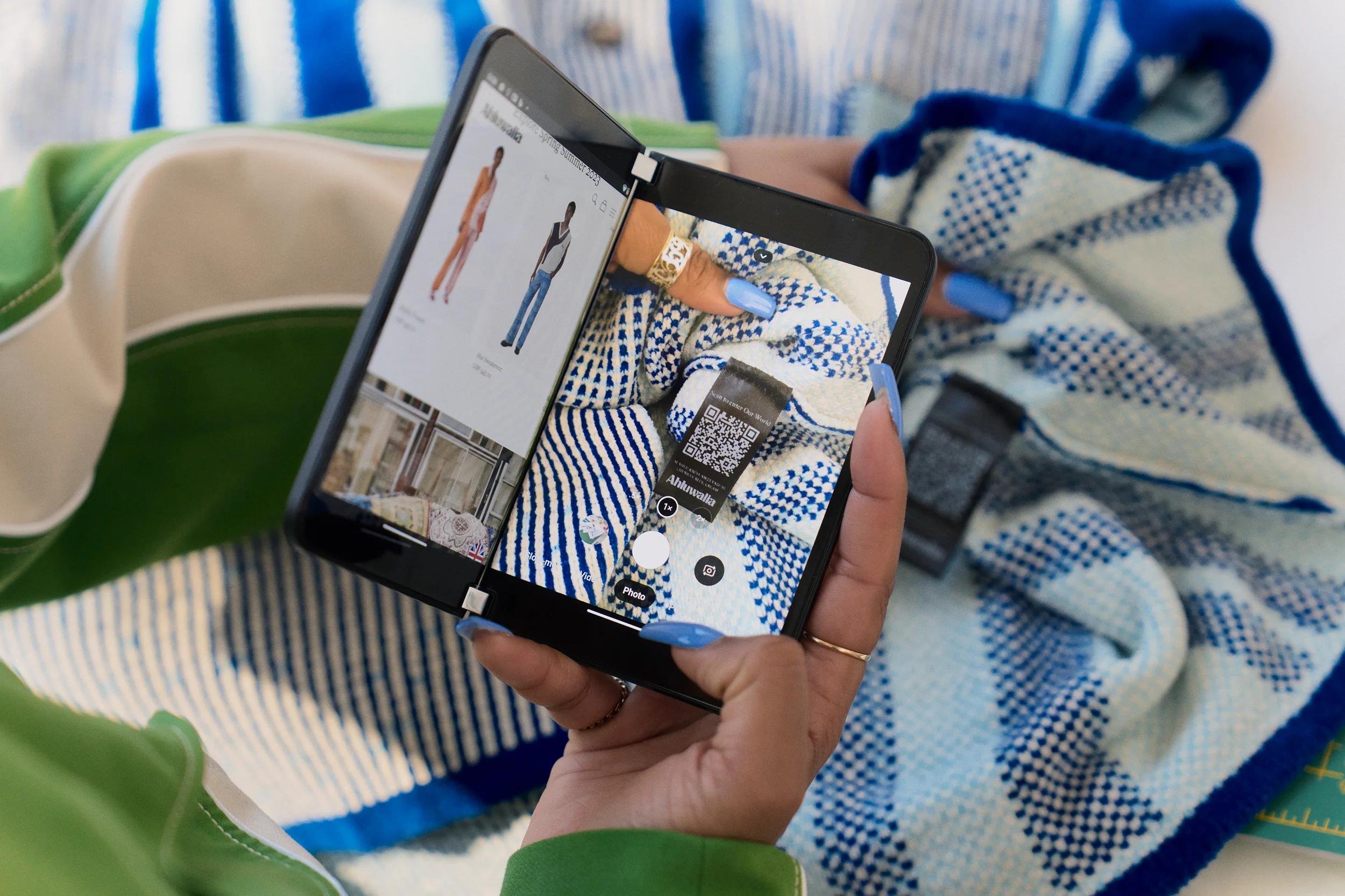
Sustainability Stories - Care
Ahluwalia products are consciously crafted with extreme care for the environment. By using recycled materials, such as fabrics made from post-consumer waste or deadstock materials, we minimise our reliance on virgin resources and reduce the carbon footprint associated with the production process. Ahluwalia’s mission to create, innovate and design whilst driving social and environmental change extends towards the care of its end product.
One of the key aspects that helps facilitate this is our care labels. This label serves as a reminder about the importance of following the care instructions provided for extending the life cycle of their Ahluwalia clothing. By understanding how to properly care for your garment you can further minimise damage and reduces unnecessary waste.

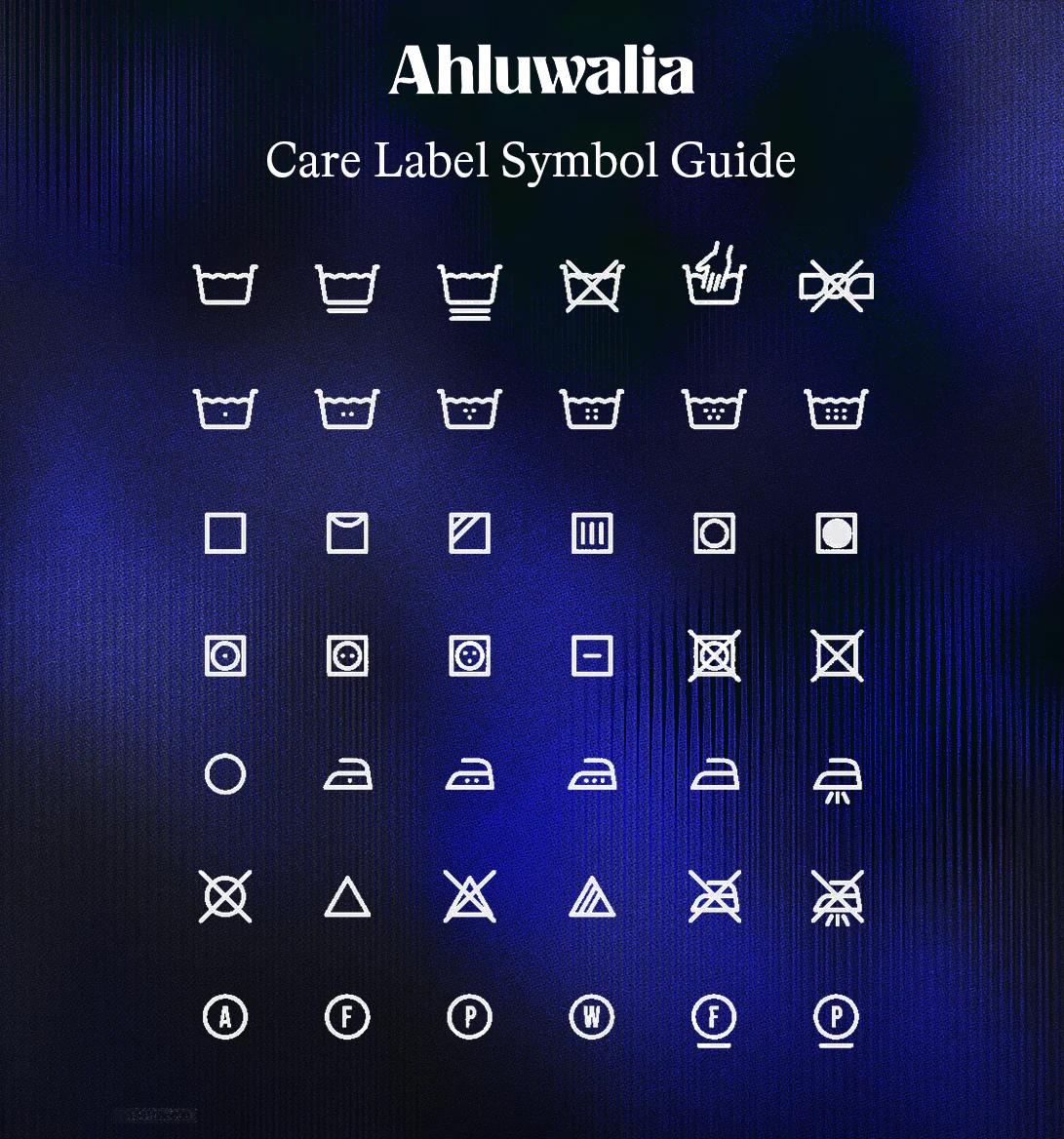
The Ahluwalia care label contains laundry symbols that will help you maintain your garment. All laundry symbols have specific meanings so we have put together a guide to help you understand them better.
Dry Cleaning Symbols
If the care label has a small circle it states that you must dry clean the item.
If there is a little letter inside the circle it indicates what chemical to use for the dry cleaner.
If there are bars underneath the circle it indicated the level of precaution the dry cleaner must take.
If there is a cross over the symbol you should not dry clean the item
Ironing Symbols
If the care label has the iron symbol with no dots you can iron the item at any temperature.
The number of dots on the iron symbol suggests the temperature of heat that can be applied:
1 dot: delicates i.e., silk and wool.
2 dots: synthetics.
3 dots: linen and cotton.
If there is a cross over the symbol you should not iron the item.
Drying Symbols
If the care label has a circle inside a square it indicates that the item can be tumble dried
The number of dots on the symbol suggests the temperature of heat that can be applied:
1 dot: low temperature
2 dots: medium temperature
3 dots: high temperature
If there is a cross over the tumble dry symbol it indicates that you should not tumble dry the item
Washing Symbols
If the care label has a tub it indicates that it can be washed in the washing machine.
The number on the tub symbol indicates the maximum temperature that can be applied to the item.
If the tub symbol has a cross over it indicates that you should not machine wash the item.
If the tub symbol has a hand it indicates that the item can be hand washed or put in a delicate washing cycle of 40°C/104°F, or lower. Hand washing is suggested better for delicate items, like cashmere or silk, because the wash is gentle preventing shrinking or snagging.
If the care label has a twisted symbol it indicates that your item can be wrung.
If the care label has a cross over the twisted symbol you must not wring the item.
Bleaching Symbol
If the care label has a triangle symbol it indicates that you can safely bleach the item
If there are diagonal lines inside the triangle it indicates that nonchlorine bleach must be used.
If there is cross over the triangle symbol it indicates that the item cannot be bleached.

By choosing our products you can enjoy luxury and high-quality clothing while actively supporting a brand that prioritizes both fashion and the planet. With Ahluwalia, the journey of responsible fashion begins with reading and following the care instructions on their clothing pieces,
ensuring longevity and reducing the environmental impact of each garment.
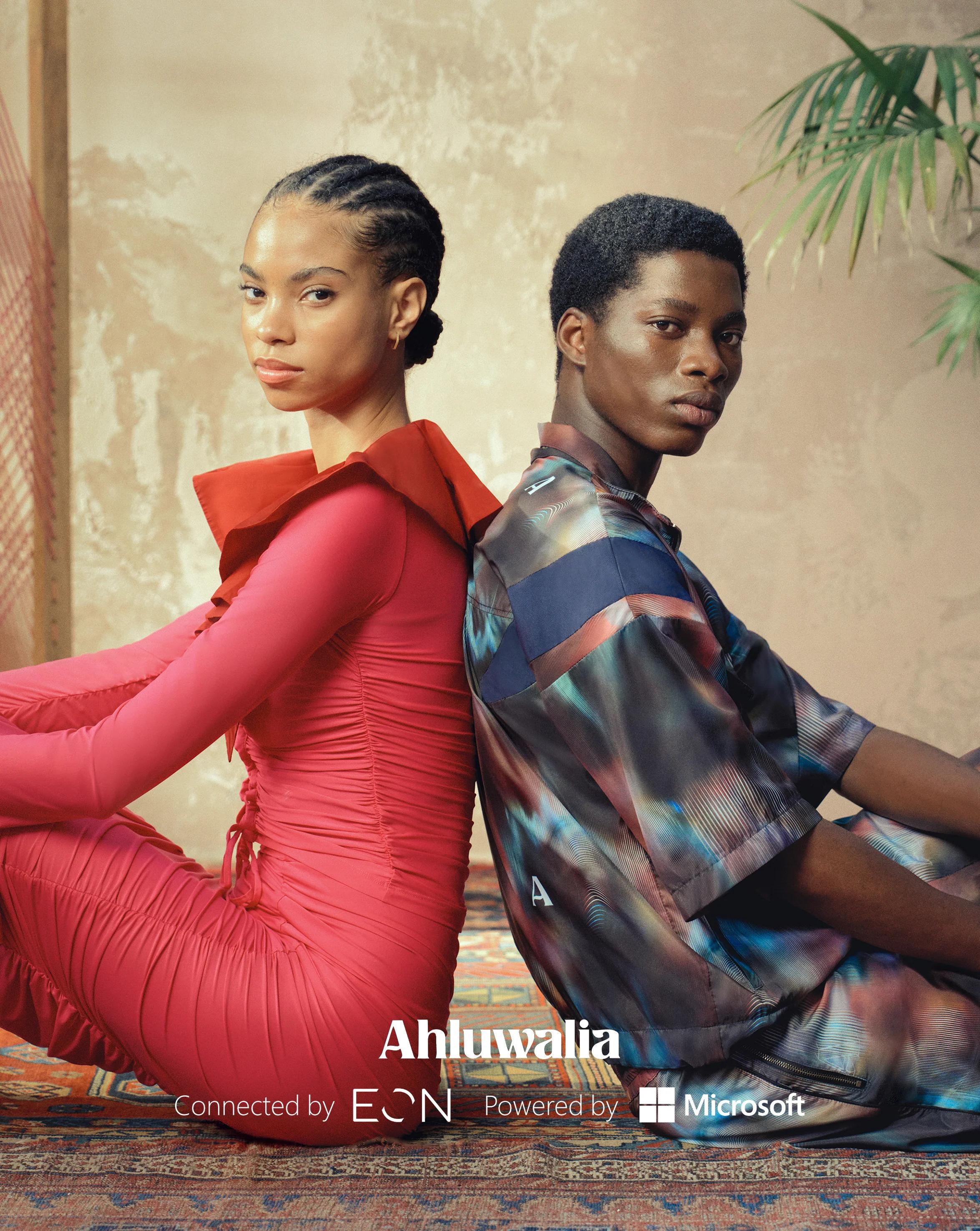 Ahluwalia
ConnectedbyESN Poweredby Microsoft
Ahluwalia
ConnectedbyESN Poweredby Microsoft
Symphony Unlocked
Ahluwalia presents Autumn Winter 2023 ‘Symphony collection’, connected by EON. Powered by Microsoft. The collection and the stories behind them are connected by EON's cutting-edge digital ID technology, and powered by Microsoft Azure. Creating an experience that transcends clothing.
These digital identifiers can be found on the garments above the care label and can be easily accessed through a smartphone or other devices to provide a wealth of data including the detailed information about the garment, materials used, care instructions along with exclusive content from the collection. Empowering our community to make more informed decisions and choosing products that align with their values for a deeper connection.
My Notes:
Page 1
consciously crafted with extreme care for the environment post-consumer waste or deadstock materials, we minimise our reliance on virgin resources and reduce the carbon footprint associated with the production process care labels
These need to be present on the collaboration T-shirts.
extending the life cycle
minimise damage and reduces unnecessary waste. Page 2
Dry Cleaning Symbols Page 3
Ironing Symbols
Drying Symbols
Washing Symbols
Bleaching Symbol
Very informative.
Page 4
luxury and high-quality clothing while actively supporting a brand that prioritizes both fashion and the planet. With Page 5
ensuring longevity Page 6
digital ID technology,
Represents an importance in the acknowledgment of latest digital movements - could incorporate the use of AI into the collaboration?
These digital identifiers can be found on the garments above the care label and can be easily accessed through a smartphone or other devices to provide a wealth of data including the detailed information about the garment, materials used, care instructions along with exclusive content from the collection. Empowering our community to make more informed decisions and choosing products that align with their values for a deeper connection.
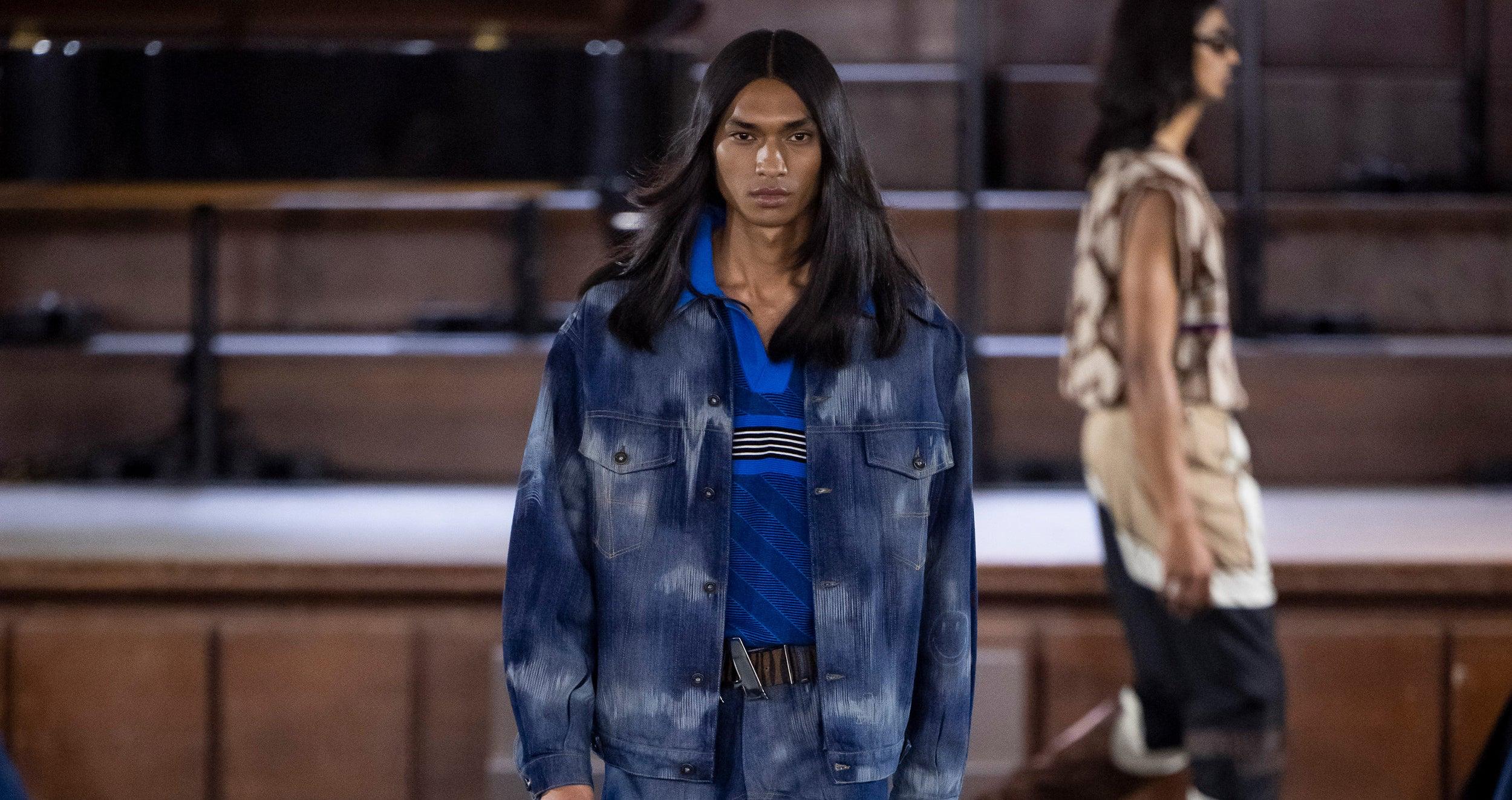
AW23 Denim Story
For Symphony AW23, the runway was sedulous rife with sunset-hued ensembles, exaggerated plush velvet collars, and soundwave motifs running through shirts. But it was denim that dominated the runway.
This season, a flurry of looks were constructed using upcycled denim from deadstock fabrics and vintage denim clothing. From jackets to lowrise jeans and mini skirts, the collection reimagined all the ways in which the Ahluwalia customer - or admirer - could be consciously stylish and fashion-forward. All denim garments were made from an Oeko Tex certified denim cotton, of which has achieved high industry standard. Identifying that the industry continues to have a problem with deadstock materials, AW23 was yet another opportunity for Ahluwalia to lead the charge in repurposing and reducing the impact of deadstock. Our creative director, design and development are widely invested in the execution of this, going to and enlisting the help of fabric mills and in turn, creating alluring and well-made luxury garments.
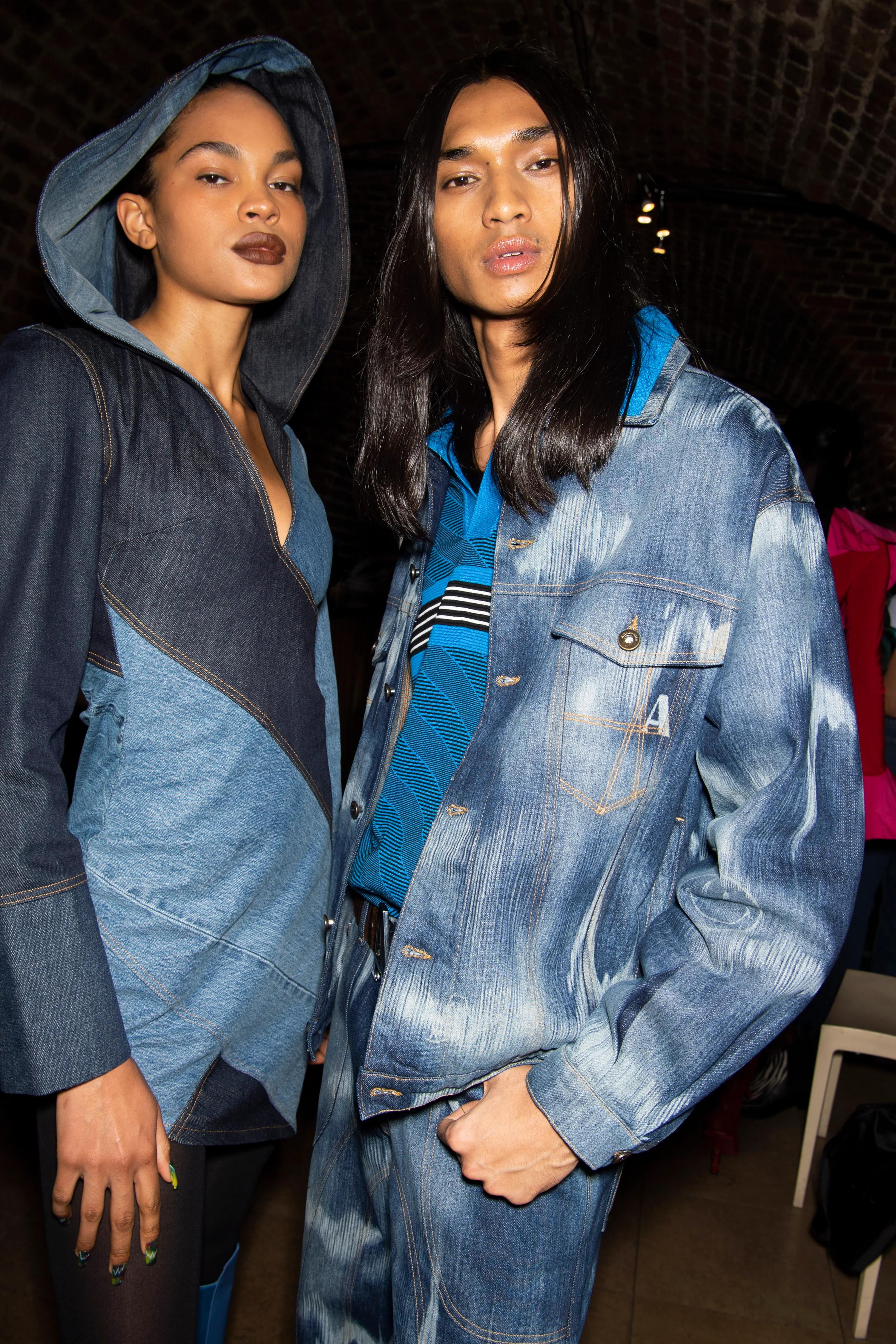


With music at the forefront of Symphony, it was natural that denim would somehow make its way into the collection for AW23. For the show’s soundtrack, Ahluwalia worked with Woodgrain Studio to curate an eclectic mix of sounds that filled the (roughly) 14 minute show with immense nostalgia, leaving many rushing to add beloved songs to their playlists. As the audience shifted, bounced and toe-tapped in their
seats, it was clear that not only was the music booming, but the clothes were too - and denim played a key part in that.
Songs such as Sade’s Kiss of Life, Lauryn Hill’s Doo Wop (That Thing), and Mario’s Just a Friend to Gyptian’s Hold Yuh and Wayne Wonder’s No Letting Go, these staple sounds from the late 80s to 90s were an important backdrop for denim’s history, and the heavy fabric certainly proved its durability. At present, it remains a principle material for those in-the-fashion know and is a wardrobe must.
A motif that ran throughout the collection was soundwaves and or diamond-shaped patterns that served as nods to inspirations that showed up in its research. From vintage guitars to traditional South Asian instruments, their intricate etches inspired the design elements emblazoned on much of the garments in Symphony, and the denim pieces especially showcased that.
Ingrained in the seams and foundation of the brand is durability, and for Symphony, its denim pieces added that everlasting touch. It was only right that for a collection that served as a celebration of Ahluwalia’s own Indian-Nigerian heritage, from Priya’s youth and upbringing to the moments that inspired her along the way, that denim followed suit as well.

My Notes:
Page 1
upcycled denim from deadstock fabrics and vintage denim clothing consciously stylish and fashion-forward.
Tell a re imaginative story of wearing consciously crafted products.
Oeko Tex certified denim cotton,
Further research Oeko Tex and where it comes from.
Page 3
A motif that ran throughout the collection was soundwaves and or diamond-shaped patterns that served as nods to inspirations that showed up in its research.
durability, and for Symphony, its denim pieces added that everlasting touch
Priya Ahluwalia: I’m so much more than just a ‘sustainable designer’
Priya Ahluwalia talks to Yolanthe Fawehinmi about musical influences and sustainability in fashion.
Yolanthe Fawehinmi
Priya Ahluwalia’s show has become a highlight of the London Fashion Week calendar (Ron Timehin for Microsoft/PA)
Stay ahead of the trend in fashion and beyond with our free weekly Lifestyle Edit newsletter
When fashion designer Priya Ahluwalia walked into the dress rehearsal of her autumn/winter 2023 London Fashion Week show in February, she couldn’t stop crying.
Titled Symphony, the show was staged at a formerly baroque church hall, with models walking to jazz-infused renditions played by pianist Insxght and saxophonist Solaariss.
“I was just so emotional,” the 30-year-old founder and creative director of Ahluwalia says. “It was like the culmination of a big deep dive coming together. That’s how I felt.”
Ahluwalia rediscovered the music of her youth when designing the collection. “I don’t like to do things in an obvious way,” Ahluwalia admits. “As life changes, you listen to different things at different stages, so I thought about the visuals of what music sounds like
when designing Symphony.
“I Will Always Love You by Whitney Houston was on the radio when I was born. So my mum finds that song really special and played it to me a lot. Sade’s Kiss Of Life was quite informative, and 50 Cent was also in there too. I remember getting one of his albums when I was 10 and thinking it was phenomenal. I also thought a lot about Prince, Queen, Freddie Mercury and even traditional Punjabi music.”
Sound waves and musical notes inspired the lasered print on denim, jacquard patterns on mohair knitwear and track tops with accompanying shorts. Earthy shadows, reds and ochres were taken from the colours of album covers and illuminated cotton separates.
Ahluwalia launched her eponymous fashion label in 2018 after graduating from the MA Menswear course at the University of Westminster, combining her dual Indian-Nigerian heritage and London roots, while also exploring the potential of vintage and surplus clothing.
Around that time, Ahluwalia visited her father in Nigeria and says she noticed “hawkers” wearing secondhand clothing from the UK. “I was really confused and started to ask questions about it,” she says –and it led to the publishing of her first book, Sweet Lassi, exploring the secondhand clothing industry in the Global South.
“Finding ways for people to cherish their clothing forever has always been important to me,” Ahluwalia says. “Microsoft and I worked on a platform called Circulate in 2021, where we use AI to crowdsource and categorise people’s unwanted clothing. But now, I think consumers really see the value in learning about the things that happen behind the scenes of the clothes they are purchasing.”
It’s why individual garments from the Symphony collection feature
Digital ID technology — created and connected by the EON Product Cloud platform, powered by Microsoft Azure. Ahluwalia customers can scan with their mobile phones to discover their item’s unique story, including the design inspiration, production processes and origins of the sourced materials, helping consumers better understand how their clothes can be resold, reused and recycled.
“This gives us the opportunity to really share exclusive content and information about a product. As a contemporary luxury brand selling items that are around £400, it’s important to provide our customers with more value and share the stories behind their clothes, whilst encouraging them to engage with sustainability.”
But Ahluwalia doesn’t want to be pigeonholed as a sustainable designer. “I’m so much more than making the right choices,” she says. “I’m a designer first and foremost, who is also a creative director, filmmaker of Joy and Beloved, who works sustainably to explore and redefine the inherent beauty of blackness [and brownness] through an authentic lens.
“The vision is that one day someone would be sitting on Ahluwalia in their front room, watching it, wearing it, smelling it and eating it. A whole 360. I would love Ahluwalia to be an example of how ideas that are not so rooted in Eurocentric values are expandable and amazing on a global stage for people to interact with in a global sense, like we see with many traditional European [fashion] houses.”
So what’s next for the fashion house?
“We’re doing a show at London Fashion Week in September, but I can’t tell you anything about it. The only thing that I can tell you is that we’re holding the show at the British Library, which I’m really excited about.”
My Notes:
Page 1
Priya Ahluwalia: I’m so much more than just a ‘sustainable designer’
Yolanthe Fawehinmi
Page 2
Sound waves and musical notes inspired the lasered print on denim, jacquard patterns on mohair knitwear and track tops with accompanying shorts.
Earthy shadows, reds and ochres were taken from the colours of album covers and illuminated cotton separates.
Prints and colour palettes echo her stories.
dual Indian-Nigerian heritage and London roots, while also exploring the potential of vintage and surplus clothing.
Ahluwalia visited her father in Nigeria and says she noticed “hawkers” wearing secondhand clothing from the UK. “I was really confused and started to ask questions about it,” she says – and it led to the publishing of her first book, Sweet Lassi, exploring the secondhand clothing industry in the Global South.
“Finding ways for people to cherish their clothing forever has always been important to me,” Ahluwalia
AI to crowdsource and categorise people’s unwanted clothing.
value in learning
This is something that needs to be encouraged within Generation Z.
Page 3
Digital ID technology
Ahluwalia customers can scan with their mobile phones to discover their item’s unique story, including the design inspiration, production processes and origins of the sourced materials, helping consumers better understand how their clothes can be resold, reused and recycled.
important to provide our customers with more value and share the stories
behind their clothes, whilst encouraging them to engage with sustainability.”
Ahluwalia's Story
Whilst studying MA Menswear at The University of Westminster, Priya visited family in Lagos, Nigeria where she began to notice traders wearing obscure British clothing.
Curious, she began to ask questions about the clothes' origins and was told of Aswani market where second-hand clothes from Europe and the US often end up. Wanting to know more, Priya dug deeper and learnt about Panipat in India, the global capital of recycling garments in the world where she visited and documented the process.
These trips informed the ethos for Ahluwalia, and today, environmental and socially positive practices are at the core of the brand and we acknowledge that we have a key role to play as a producer in an imperfect industry.
Ahluwalia's Practice
At Ahluwalia, we are dedicated to creating beautifully designed clothes that are made to last and to be cherished, whilst innovating positive methods of production and business practice.
Ahluwalia garments are made at female-owned factories and created using surplus and post-consumer fabrics, as well as recycled and organic materials which contributes to our reduced carbon footprint, and positively impacts biodiversity by saving things from landfill.
Ahluwalia strives to measure and understand it's own impacts with continuous analysis of our working practices, coupled with training and education. We aim to use these learnings to continuously improve and build towards a regenerative brand.
Ahluwalia will continue to further the messages of equality and celebrate the beauty and importance of cultural diversity and social inclusivity, as well as be conscious of the impact of fashion on people and the planet –these are core values which the brand has been built upon.

My Notes:
Priya visited family in Lagos, Nigeria where she began to notice traders wearing obscure British clothing.
Aswani market where second-hand clothes from Europe and the US often end up
learnt about Panipat in India, trips informed the ethos for Ahluwalia
At Ahluwalia, we are dedicated to creating beautifully designed clothes that are made to last and to be cherished, whilst innovating positive methods of production and business practice. Ahluwalia garments are made at female-owned factories and created using surplus and postconsumer fabrics, as well as recycled and organic materials which contributes to our reduced carbon footprint, and positively impacts biodiversity by saving things from landfill.
continuous analysis of our working practices
training and education
regenerative brand.
2 November 2021


As a designer working primarily with vintage and deadstock materials, Priya Ahluwalia’s creative process looks radically different from most. While her peers are ordering yards of custom silks and cottons from Italy, she and her team are digging through London warehouses and stockrooms for unused fabric and gently-worn clothes to transform. It’s an imperfect, intuitive system rooted as much in a reverence for the past as sustainability; Ahluwalia grew up with heirlooms and hand-medowns from her Indian and Nigerian families, and wants to bring that emotion back to modern clothing.
Looks from Ahluwalia’s spring 2022 collection Photo: Courtesy of AhluwaliaHer talent and perspective have put Ahluwalia’s business on a rapid incline: she’s picked up a host of new stockists, won multiple awards, participated in Gucci Fest, collaborated with Ganni, and produced a series of short films. The Ahluwalia team is busy, to say the least, and more demand means more trips to the warehouses – but sometimes, there just isn’t enough product available. “It’s a good problem to have since the business is growing, but with deadstock and vintage, there’s an access problem,” Ahluwalia says. “Fashion brands aren’t used to working this way – it isn’t as simple as ordering more fabric from a mill. If we don’t have enough [deadstock and vintage garments], it can create holes in production, which can be quite scary. We want to fulfill all of our orders, and we always think of solutions, but it increases our production timelines.”
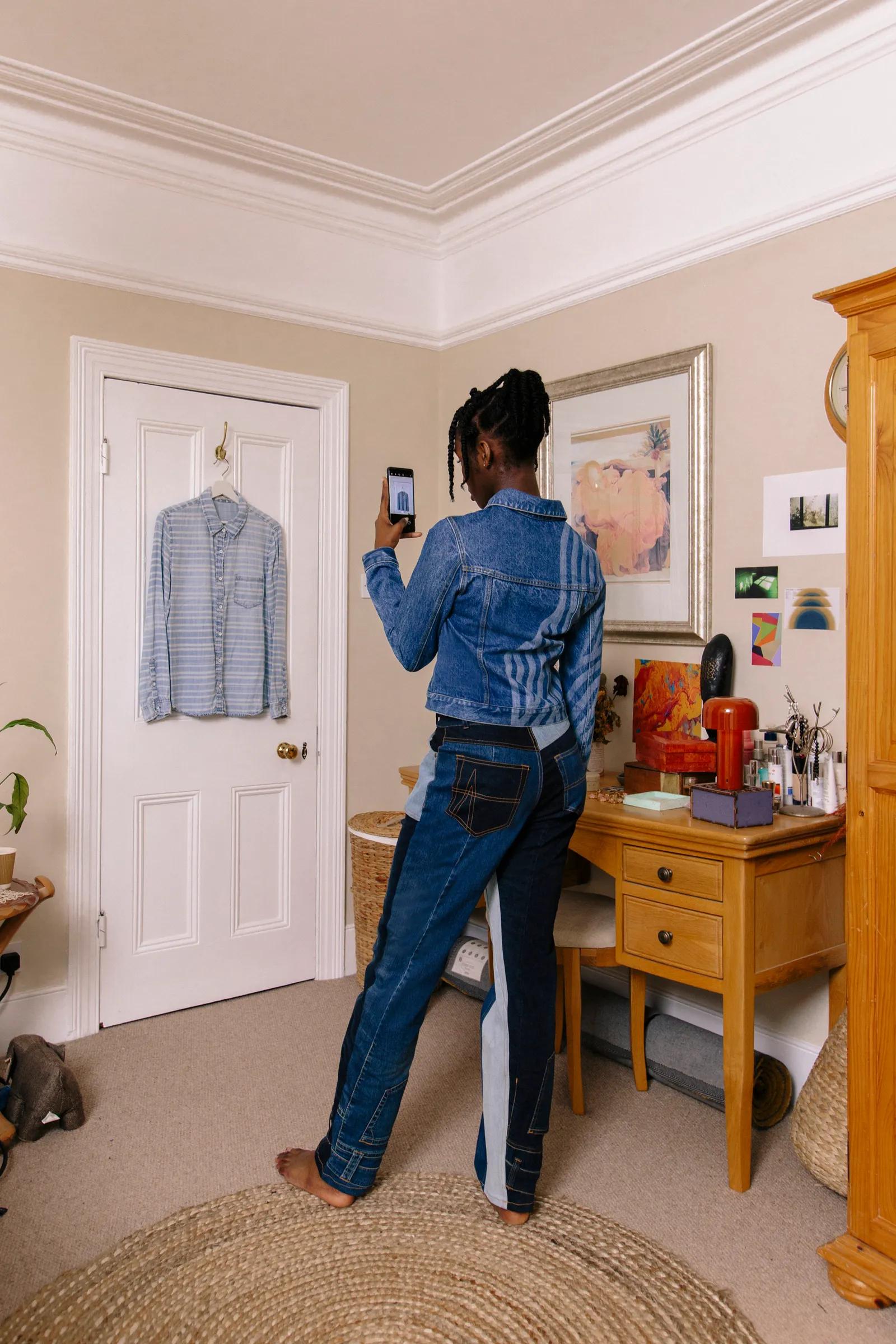 Photo: Courtesy of Priya Ahluwalia and Microsoft
Photo: Courtesy of Priya Ahluwalia and Microsoft
That raises the question we’ve heard time and time again: how do you scale upcycling? A call from Microsoft sparked a way forward. “About a year ago, Microsoft approached me to collaborate on a virtual reality or digital fashion show, but I just felt that if I had the chance to collaborate with a tech giant, I wanted to develop something that would actually solve a business issue,” Ahluwalia says. “Showing fashion digitally is amazing, and some brands have done it fantastically, but it isn’t going to help with the nuts and bolts of producing my collections.”
The idea Ahluwalia pitched to Microsoft is up and running today: Circulate is a new digital platform designed to crowd-source clothing from the local community. Launching in a beta version, the experience is straightforward: users upload images of a garment they’d like to donate, and Microsoft’s Computer Vision API analyses and sorts it into a database. Ahluwalia’s team will check the submissions as well, and once the garment is accepted, a shipping label is sent to the user to mail it to their warehouse.

“There was a lot of back-and-forth about how this could serve not just production, but also design,” Ahluwalia adds. “If I can look in the backend and see that we have quite a lot of denim jackets, it might lead me to design something with them, because I want to use what we have available.”
Mock-ups of Circulate’s user experience and call-outs
Ahluwalia’s team will post “call-outs” for specific garments throughout the year: if they’re in need of striped shirts and floral dresses, for instance, they’ll leave the call-out open for months so they can continuously source. “We’re hoping that because people want to engage with this, it will really allow us to preempt things we need,” she says. “If I design a collection in October that will be shown in January, and I want to use blue cotton shirts, I can leave that call-out open [from October] until we start production in February. We can keep actively sourcing in the background, even if we aren’t in what is normally our ‘sourcing period.’”
The hope is that Circulate will streamline and bolster Ahulwalia’s design and production processes, but it’s also creating a new way for people to participate in the brand without actually making a purchase. Fans of the label might be excited to contribute to an Ahluwalia garment – a concept that is rarely available in fashion – and Londoners who are purging their closets could be happy to know where their clothes are going.
“People can’t source like this normally, and this way, I can try to rely on
the community I’m trying to build, rather than the supply chain,” Ahluwalia adds. “I find it frustrating that the onus for sustainability is always put on designers. It’s really bizarre – there are so many other people and stakeholders in this industry. People want to do their best, but it isn’t that easy. If you want to be a designer who works responsibly, it doesn’t mean the ecosystem you operate in is set up for that. You could have the best intentions, but it might not work. So for me, this is a way to take control of those issues and figure out my sourcing in a new way.”
Ahluwalia’s typical sourcing process involves visiting warehouses and secondhand markets; here, a photo from a recent trip to India
The platform will be available to anyone in the UK, with plans to expand into other markets soon. “The idea is to add locations where our factories are,” she adds, in order to limit international shipping and transport. “We have our denim factory in Italy, so ideally we would source our denim from around there and get it straight to the factory.”
My Notes:
2 November 2021
Page 1
Page 2
vintage and deadstock materials, digging through London warehouses and stockrooms for unused fabric and gently-worn clothes to transform
Ahluwalia grew up with heirlooms and hand-me- downs from her Indian and Nigerian families, and wants to bring that emotion back to modern clothing.
Emotional attachment to sustainability.
Page 3
she’s picked up a host of new stockists, won multiple awards, participated in Gucci Fest, collaborated with Ganni, and produced a series of short films
“It’s a good problem to have since the business is growing, but with deadstock and vintage, there’s an access problem,” Ahluwalia says.
This should be more accessible for the collaboration with it only producing limited quantities.
Page 5
“About a year ago, Microsoft approached me to collaborate on a virtual reality or digital fashion show, but I just felt that if I had the chance to collaborate with a tech giant, I wanted to develop something that would actually solve a business issue,” Ahluwalia says
Circulate is a new digital platform designed to crowd-source clothing from the local community.
users upload images of a garment they’d like to donate, and Microsoft’s Computer Vision API analyses and sorts it into a database.
“If I can look in the back- end and see that we have quite a lot of denim jackets, it might lead me to design something with them, because I want
to use what we have available.”
Page 6
“call-outs” for specific garments
creating a new way for people to participate in the brand without actually making a purchase.
excited to contribute to an Ahluwalia garment – a concept that is rarely available in fashion
Page 8
“The idea is to add locations where our factories are,” she adds, in order to limit international shipping and transport. “We have our denim factory in Italy, so ideally we would source our denim from around there and get it straight to the factory.”
References:
Sustainability Stories Care. (n.d.). Ahluwalia. Retrieved April 23, 2024, from https://ahluwalia world/pages/sustainability-stories-care
About. (n.d.). Ahluwalia. https://ahluwalia.world/pages/about
Sustainability Stories Denim. (n.d.). Ahluwalia. Retrieved April 23, 2024, from https://ahluwalia world/pages/sustainability-stories-denim
Priya Ahluwalia: I’m so much more than just a “sustainable designer.” (2023, July 31). The Independent. https://www independent co uk/life-style/fashion/microsoft-joy-prince-whitney-houston-british-libraryb2384824 html
Values (n d ) Ahluwalia https://ahluwalia world/pages/values
Rizi-Shorvon, E. (2023, July 26). How Ahluwalia and EON are powering sustainable fashion with tech. Microsoft News Centre UK https://news microsoft com/en-gb/2023/07/26/ahluwalia-eon-powering-sustainable-fashionwith-tech/
Nast, C (2021, November 2) Priya Ahluwalia Wants Your Old Clothes: A New Microsoft Collaboration Brings Consumers Into The Upcycling Process. British Vogue. https://www.vogue.co.uk/fashion/article/priya-ahluwaliamicrosoft-upcycling-app
Designer Priya Ahluwalia Keeps Pushing the Boundary. (2023, September 14). W Magazine. https://www wmagazine com/fashion/priya-ahluwalia-designer-interview
Nast, C. (2023, December 14). “We Are Business Owners, You Can’t Be A Wallflower”: Priya Ahluwalia, Tolu Coker & Torishéju Dumi Are Leading The Charge For Sustainable British Design British Vogue https://www vogue co uk/article/british-vogue-sustainable-fashion-designers-cover
Enabling Circularity With Ahluwalia | Avery Dennison (n d ) Label averydennison com Retrieved April 23, 2024, from https://apparelsolutions averydennison com/en/home/our-services/ad-trend-alert/Enabling-CircularityWith-Ahluwalia.html
Priya Ahluwalia has been honoured as the “Environmental Leader of Change” at the Fashion Awards. (2021, November 30) Vogue Scandinavia https://www voguescandinavia com/articles/priya-ahluwalia
Sustainability Statement. (n.d.). Ahluwalia. Retrieved April 23, 2024, from https://ahluwalia world/pages/sustainability-statement
Spotlight On: Priya Ahluwalia, the Sustainable Designer Rewriting the Rules of Menswear. (2020, December 21). HYPEBEAST https://hypebeast com/2020/12/grey-goose-priya-ahluwalia-sustainable-menswear-designerspotlight
London, L , & Gunn, Z (2023, November 13) Priya Ahluwalia is the real deal Luxury London https://luxurylondon co uk/style/his/priya-ahluwalia-interview-fashion/
Style, B (2023, October 4) Priya Ahluwalia Wins the Bicester Collection Award for Emerging Designers at CNMI’s Sustainable Fashion Awards 2023. BellaNaija. https://www.bellanaija.com/2023/10/priya-ahluwalia-2023-cnmisustainable-fashion-awards/
Designer Priya Ahluwalia championing sustainable fashion. (n.d.). The Global Indian. Retrieved April 23, 2024, from https://www globalindian com/story/global-indian-exclusive/priya-ahluwalia-indian-nigerian-designerchampioning-sustainable-fashion/
Maoui, Z (2020, September 25) Meet Ahluwalia, the designer demanding a change in the fashion industry British GQ https://www gq-magazine co uk/fashion/article/priya-ahluwalia-interview-2020
Nast, C (2021, November 10) Ahluwalia and Microsoft Collaborate on Circulate, A Web App for Upcycling Clothing Teen Vogue https://www teenvogue com/story/ahluwalia-and-microsoft-collaborate-on-circulate-aweb-app-for-upcycling-clothing
